A top-notch train ride: How to choose between Rocky Mountaineer’s most popular routes

For many travelers, no first-class airline suite or classic road trip can compete with the leisurely, decadent experience of crossing some of the world's most scenic landscapes on a luxury train.
And when it comes to the varied, dramatic scenery of western North America (the towering, snowcapped peaks of the Rocky Mountains, the Martian-like red rocks of the American West), only one brand dominates the space.
And no, it's not Amtrak.
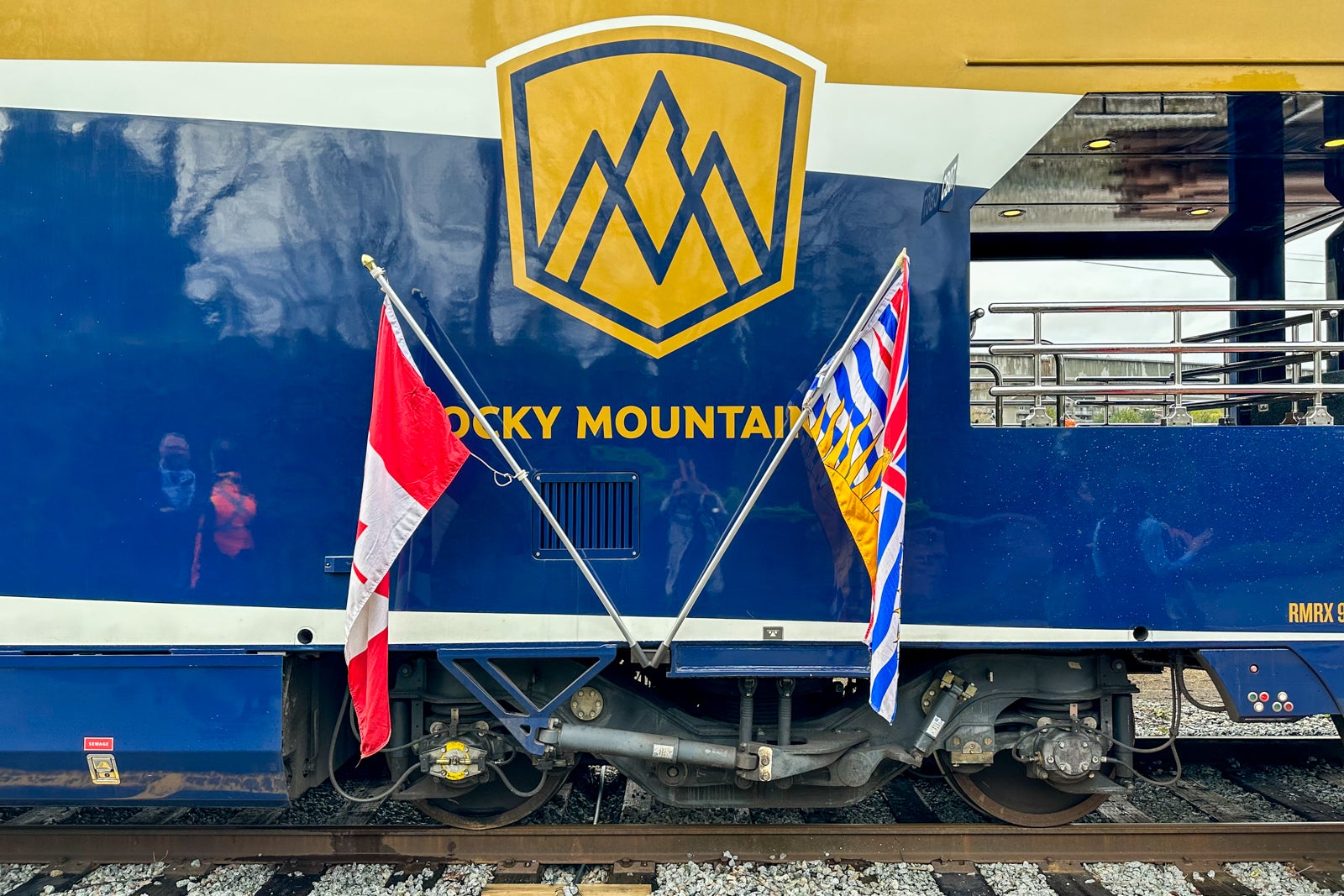
Rocky Mountaineer, a Canadian company that's been taking travelers on high-end rail tours of western Canada for more than 30 years, launched its first U.S. route in 2021. Called Rockies to the Red Rocks , this itinerary connects Moab, Utah, with Denver, Colorado, and offers travelers a new way to experience the iconic train, which has historically remained in Canada.
I got to experience that journey with my colleague, Summer Hull, last fall. And six months later, I was invited to reunite with Rocky Mountaineer on its classic First Passage to the West route. Tracing a line between Vancouver, British Columbia, and Banff, Alberta, this legendary tour includes a stop in Kamloops, British Columbia, crosses the Continental Divide and corkscrews through the Spiral Tunnels before concluding at Lake Louise and Banff National Park.
But it's not just the destinations that are different. If you're contemplating your first-ever trip with Rocky Mountaineer, here are some other differences to consider.
Related: 11 of the most scenic train rides on Earth

At your service
During my trip with Rocky Mountaineer in the U.S., I got to experience SilverLeaf Plus, the highest level of service offered on this route. For about $500 more than the entry-level fares, travelers in SilverLeaf Plus get access to more local wines and spirits and can spread out beyond the standard observation car and into the lounge cars — perfect for whiling away the hours while admiring the scenery, elbowing up to a bar (on a train!) to order cocktails, playing classic board games and exchanging stories with other travelers.
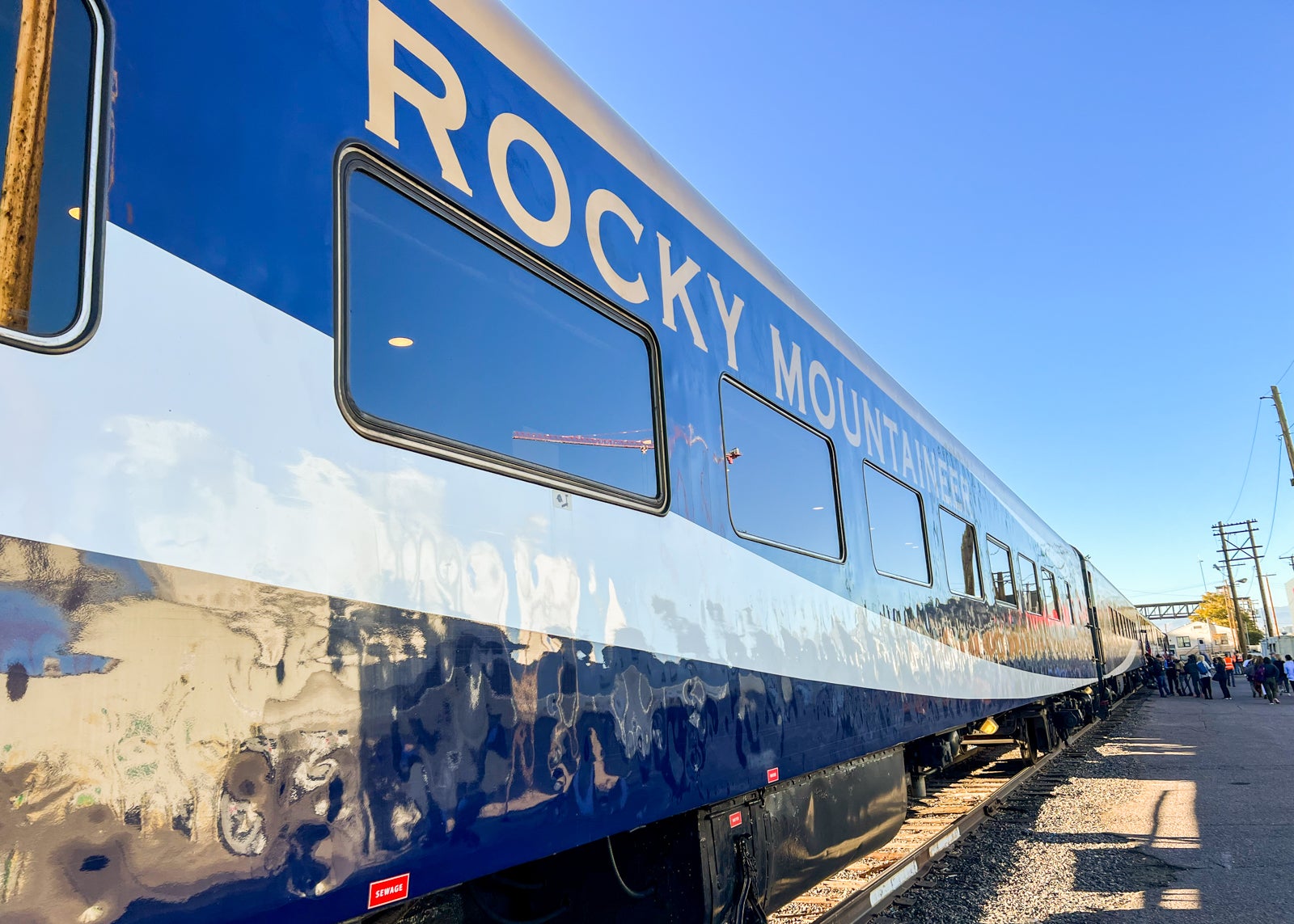
On the other hand, travelers who opt for one of the classic Canadian journeys can experience the operator's iconic GoldLeaf service. Guests in this class get to spend the journey in a double-decker car: Breakfast and lunch services are organized on the lower level, just like a fine dining restaurant (albeit a bit more turbulent), complete with white tablecloths, while the upstairs is reserved for admiring the scenery in a stunning bi-level glass-domed observation car. These cars can't fit through the lower tunnels in the U.S., so Rocky Mountaineer hasn't been able to replicate this service on its Rockies to the Red Rocks route. At least, not yet.
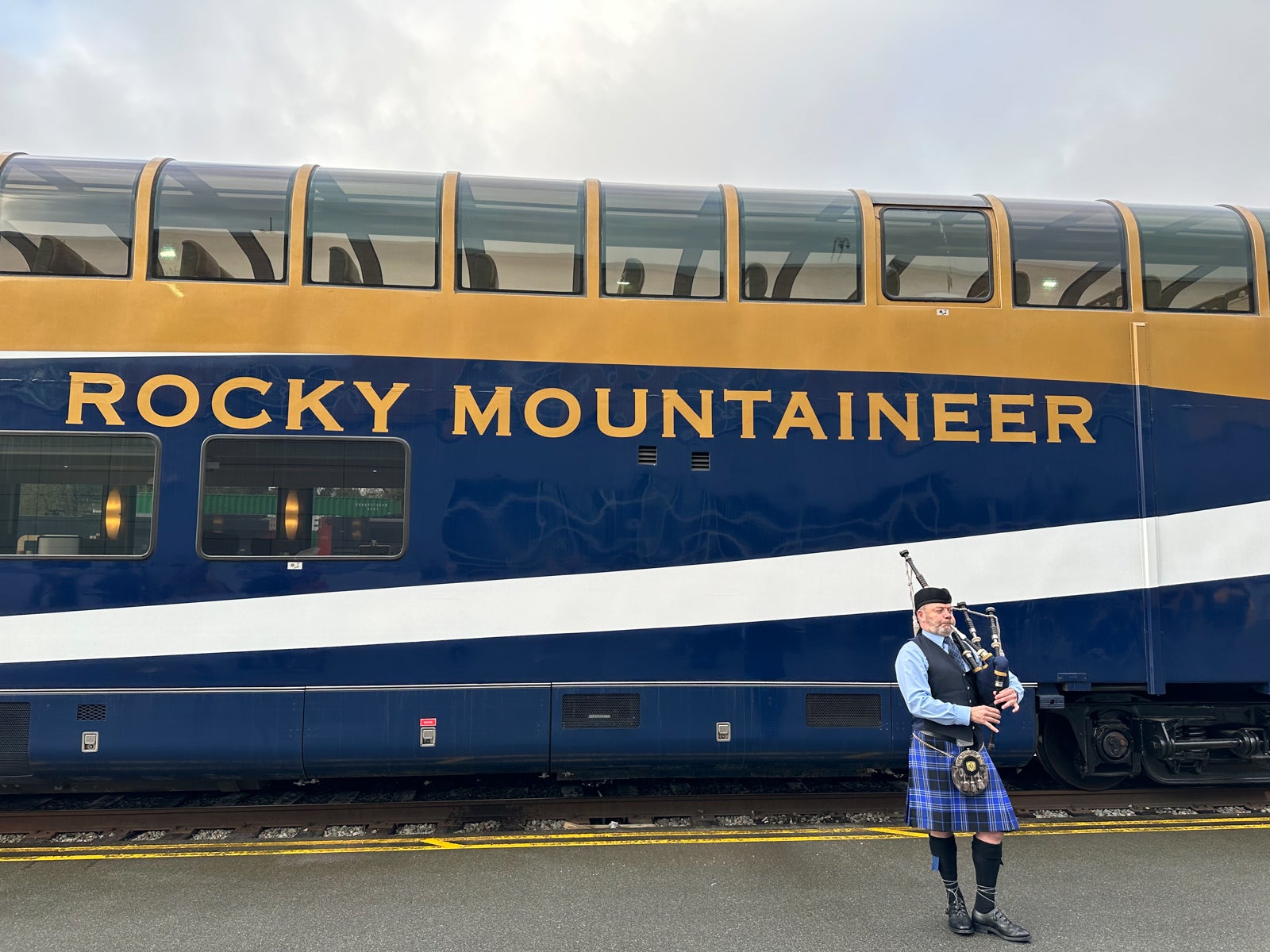
It's hard to underscore what a difference it makes to not have to take your meals at the same seat you're sitting in, napping in and chatting in for two days or more. Migrating downstairs for meal services harks back to the golden age of travel when flight attendants carved chateaubriands for flyers and entire dessert buffets were presented to guests on the Orient Express.
The GoldLeaf train cars are also much more modern, with wider, heated leather seats that swivel to create more intimate sitting areas for groups, and advanced controls to adjust everything from pitch to lumbar support.
But for travelers looking to save money, the SilverLeaf service — nearly identical to the entry-level SilverLeaf service offered on the American route — is still a far more upscale way to journey along the rails than standard passenger trains.
And even though SilverLeaf Plus is undoubtedly Rocky Mountaineer's version of premium economy, and GoldLeaf is a clear cut above (think: business class on your favorite international airline), I'll admit I missed the lounge cars while ambling along the tracks in western Canada. The lounge cars, with their player pianos and full bar service, snacks and convivial atmosphere, felt far more consistent with the romantic Agatha Christie-esque visions of rail travel I'd daydreamed about (minus the murder, of course).
Related: How to plan your 1st luxury train trip
Fine dining (and drinking)
One of the highlights of traveling with Rocky Mountaineer is the excellent food and beverage program featuring multi-course lunch and breakfast services and unlimited beverages.
During the Rockies to the Red Rocks trip, which offered three breakfast choices and two lunch options, I tucked into a breakfast frittata with roasted yams, peppers and onions, plus a side of veggie sausage (available upon request) and flavorful vegetarian flautas for an afternoon snack. Meals are served at your seat, on tray tables (airplane style, I like to call it) but are dressed up with white linens and elegant flatware.
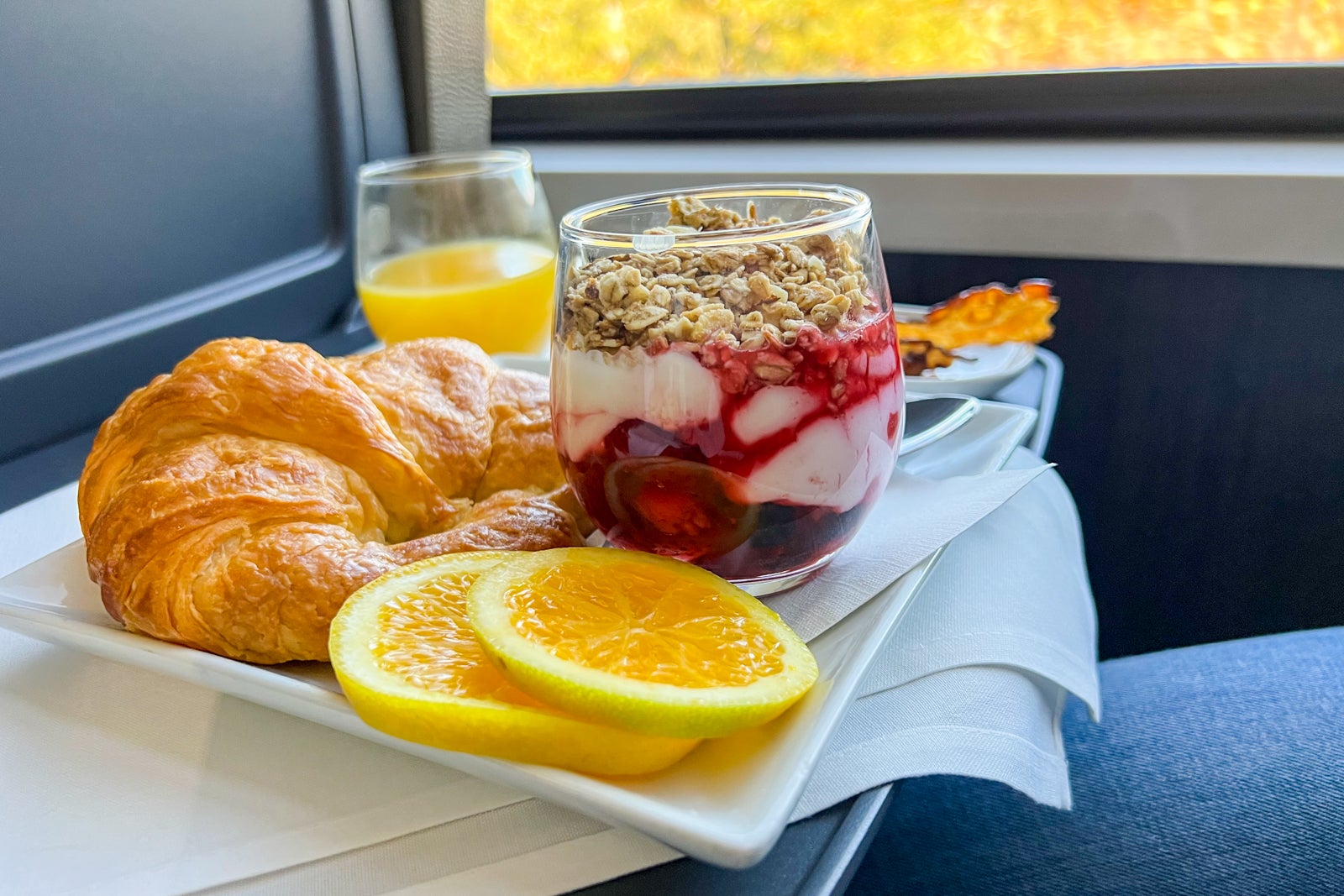
The highlight, though, was probably sipping a fresh-made bloody mary while munching on bar snacks in the lounge car, plus the assortment of pastries and desserts sourced from local bakeries along the route.
While traveling from Vancouver to Lake Louise, the dining experience was of an entirely different caliber. In addition to the luxury of not eating at your seat, each meal offered more dishes to choose from, and the food was, overall, more elaborate (Rocky Mountaineer chefs must contend with smaller galleys on the U.S. route). Throughout the two-day trip, I enjoyed plates of Lois Lake steelhead with handmade gnocchi, Moroccan-spiced cauliflower and chickpeas, and avocado toast topped with smoked salmon and a soft-boiled egg.
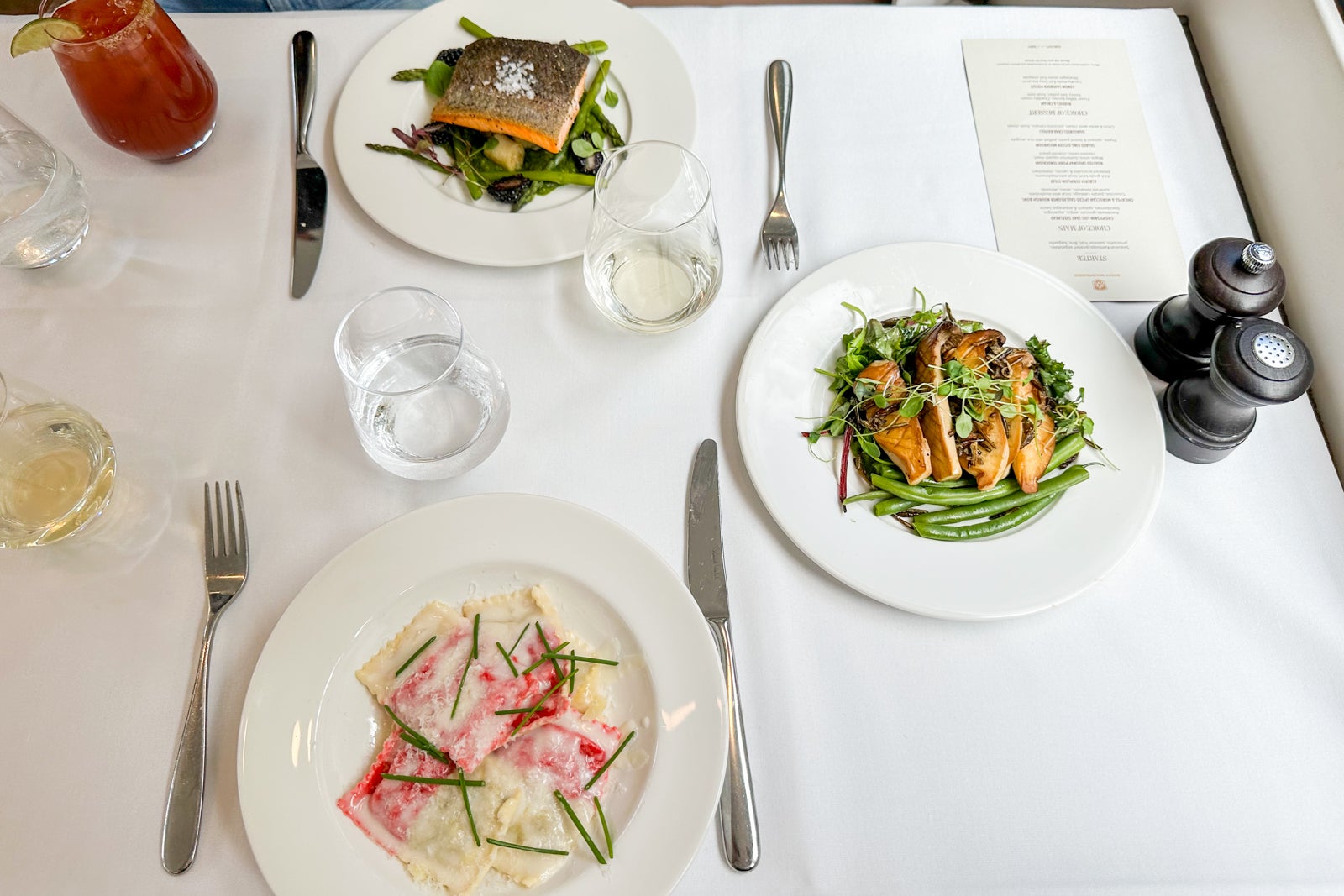
Though there were no lounge cars with bars, you could order endless beverages, including Canada's answer to the bloody mary: a caesar.
One gripe is that espresso beverages aren't served on board the Rocky Mountaineer. I know space is at a premium, but there is a galley where chefs turn out almost everything (except, specifically, birthday cakes), and I would have loved to sip a foamy cappuccino while watching the Rocky Mountains as we zipped by.
Related: 4 great scenic train rides across the US
Diverse — but equally dramatic — landscapes
There's no comparing the American Southwest and its vermillion-hued rock formations to the snowcapped spires of the Canadian Rockies.
And though both trains cross the Continental Divide and traverse the Rocky Mountains during the journey, no itinerary is better or more scenic than the next. Travelers should decide if they want to bookend a journey on board the Rocky Mountaineer with mountain biking, rock climbing and stark desert hikes in the surreal landscapes of Canyonlands and Arches National Park or if they prefer the cooler mountain temperatures of Canada's western national parks, where similar diversions might include hiking and canoeing or, in the winter, skiing and snowshoeing.
During our journey from Colorado to Utah, we passed through aspens tipped with late autumn gold, mountains covered in evergreens and the blushing sandstone cliffs of Ruby Canyon.
The train hugged the Colorado River as we continued west, steam fog rising from the water in the early morning, and we saw everything from eagles and elk to chipmunks and even bare-bottomed paddlers partaking in the time-honored tradition of mooning the passing train. Our journey concluded at the junction of some of the most iconic parklands in the U.S., including Dead Horse Point State Park, Canyonlands National Park and Arches National Park , all marked by impossibly vibrant rock formations and scenic vistas, including gravity-defying hoodoos and natural bridges.
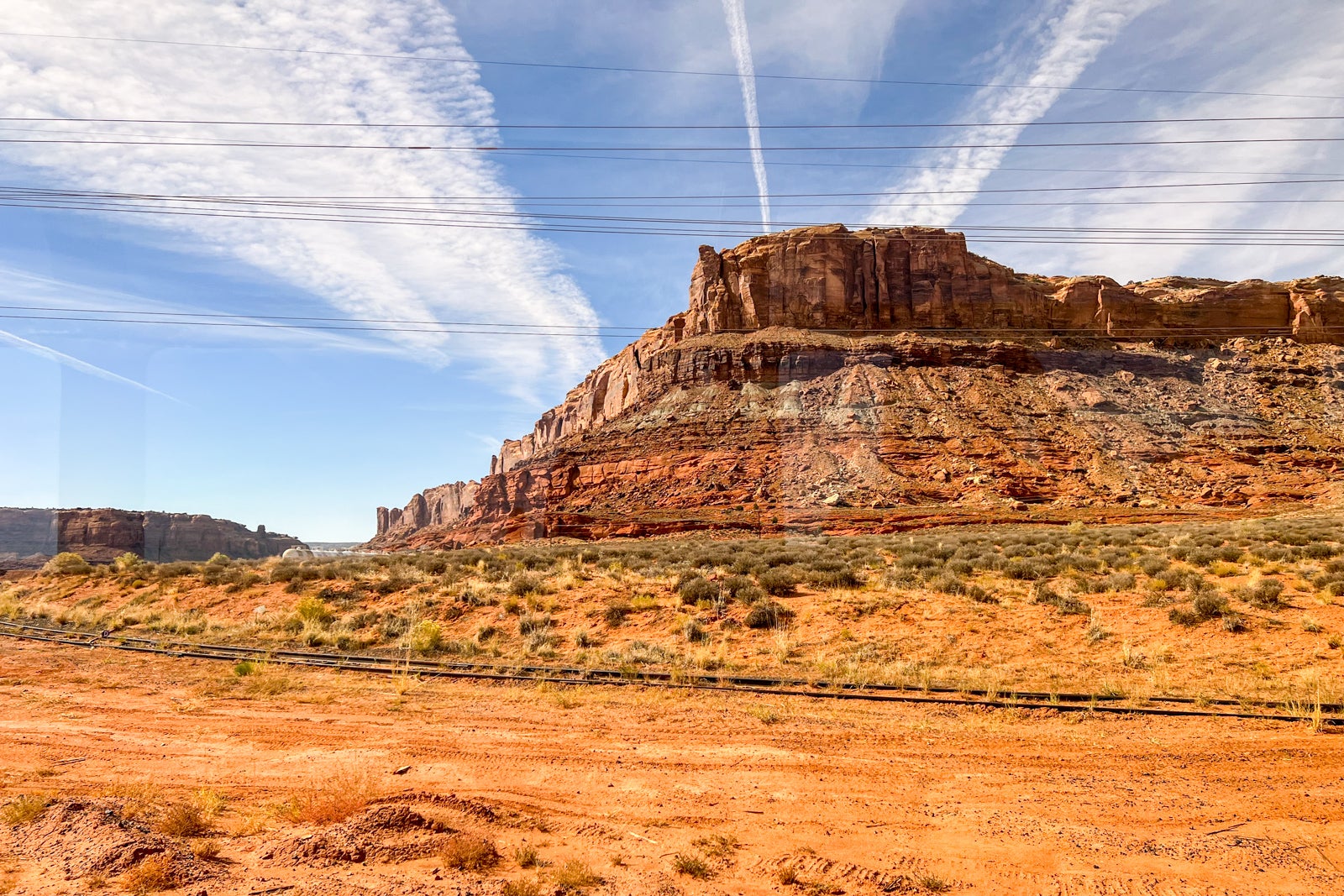
While traveling east from Vancouver to Lake Louise, the scenery was marked by the frothy whitewater rapids of Kicking Horse River, dramatic mountain passes and, perhaps most notably, the astonishing engineering feat of the Spiral Tunnels, which made the spires of the Rockies accessible with trains and provided some of the most stunning views from the entire trip.
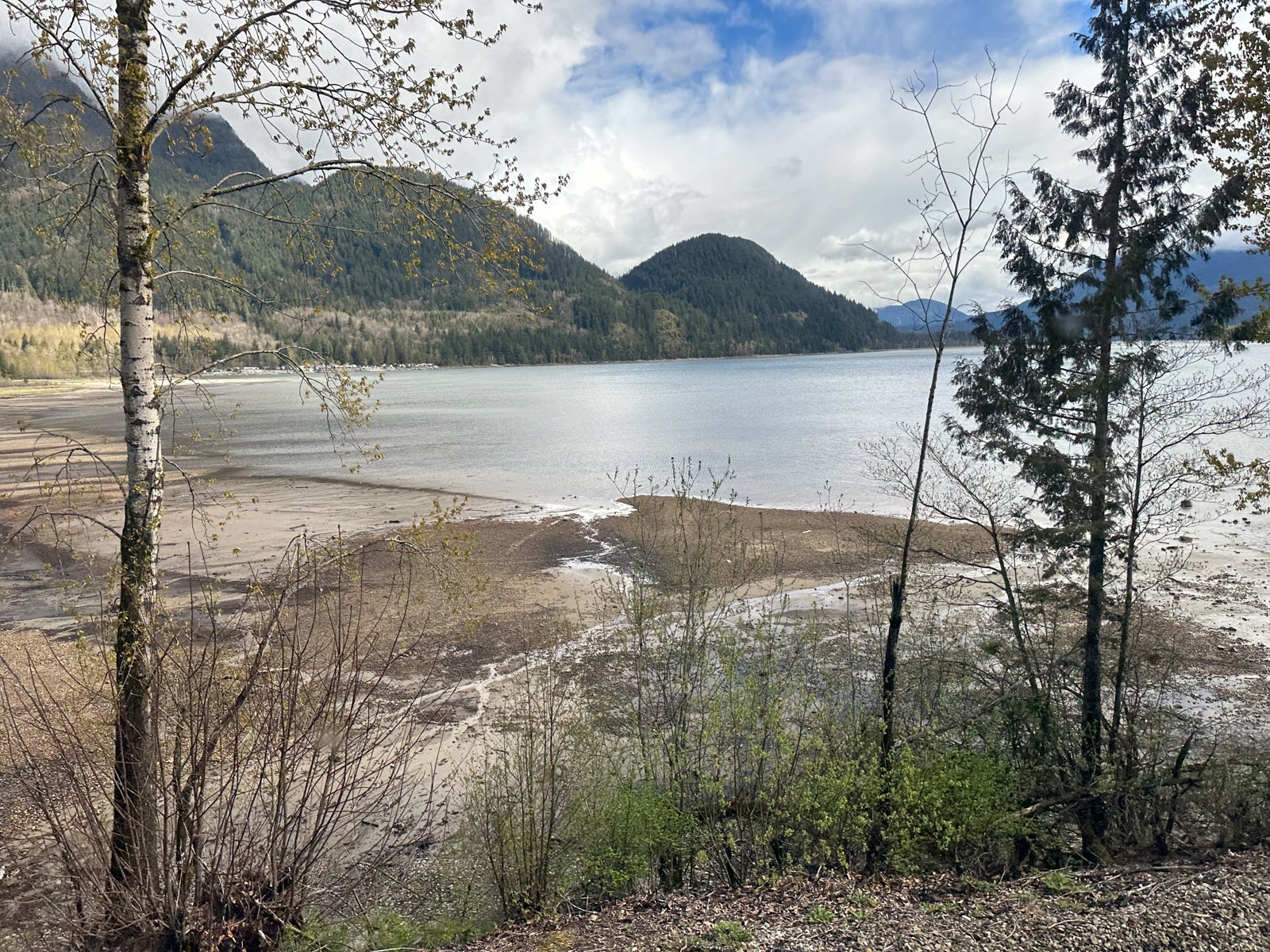
As with the U.S. journey, the wildlife we saw in Canada was surprisingly abundant, including bald eagles, elk and osprey.
It's a good thing these trains aren't equipped with Wi-Fi, because it encourages you to put down your devices and keep your eyes glued to the oversized windows.
Whistle-stops
Since Rocky Mountaineer trains aren't equipped with sleeper cars, travelers must disembark in the evening and spend the night in a hotel (these overnights are included in the cost of your stay).
I found Glenwood Springs, Colorado — the scheduled whistle-stop for the Rockies to the Red Rocks route — to be a much more appealing place to visit, in part because you can simply walk off the train and into town. During the stop, travelers can dip in the town's namesake hot springs (which claim to be the largest mineral hot springs pool on earth) and explore the walkable, distinctly Western town center.
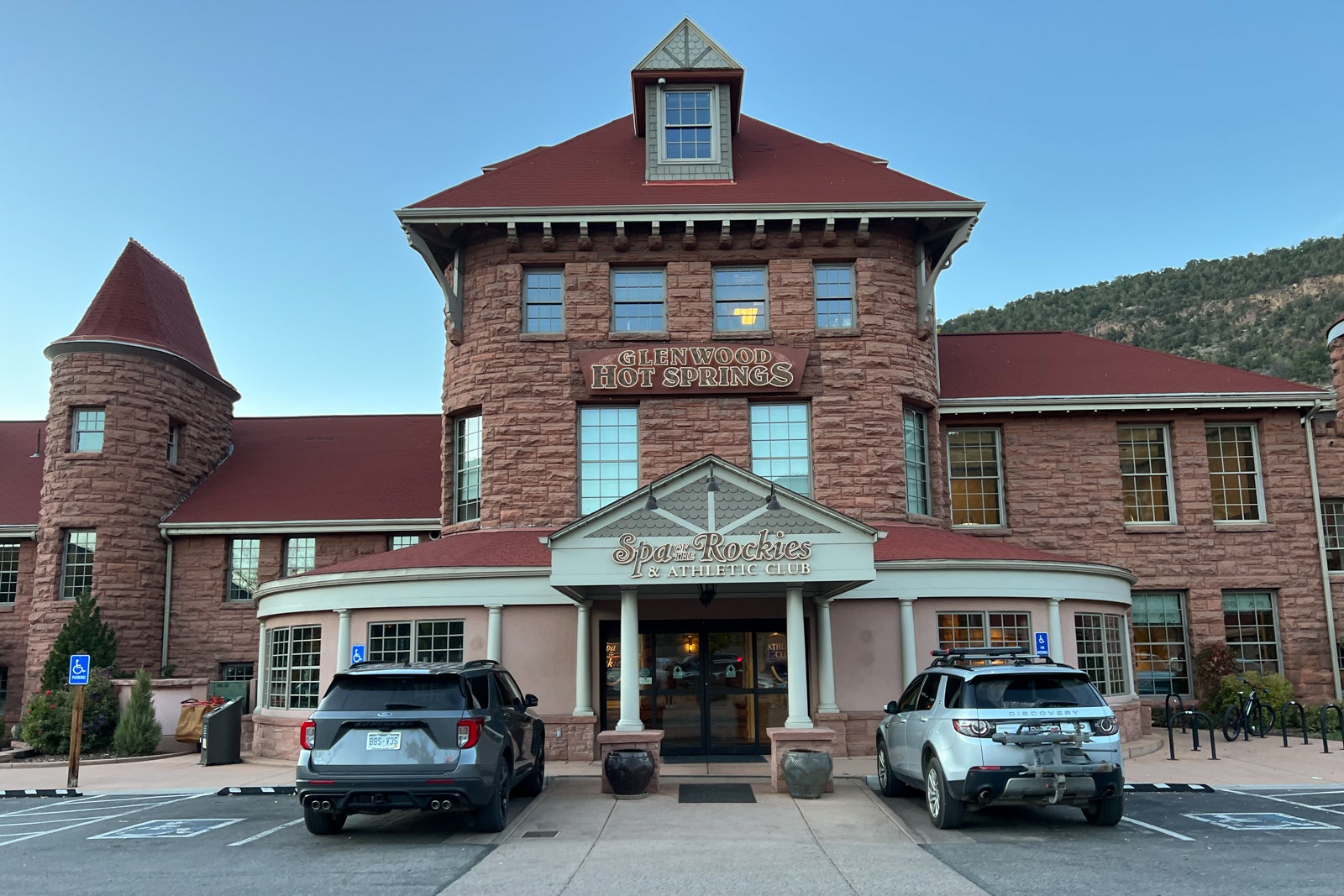
The First Passage to the West itinerary includes a stop in Kamloops — a city (population: approximately 100,000) known for hosting sporting events that didn't feel as approachable for a quick overnight. After disembarking, travelers must board a bus to the town center. Admittedly, we arrived later in the evening on this trip and only had time for a quick bite at The Noble Pig, a microbrewery specializing in hand-crafted beers and fried pickles.
But Kamloops does have a distinct edge with its accommodations, which feel appropriate for the Rocky Mountaineer experience. We spent the night at the Delta Hotel Kamloops, a rebranded and renovated property that welcomed guests in 2019. The contemporary downtown hotel is hardly a Fairmont (the iconic grande dame hotels that bookended our stay in Vancouver and Lake Louise ). Still, it felt fresh and featured thoughtful amenities like argan oil Soapbox toiletries and a heated rooftop pool.
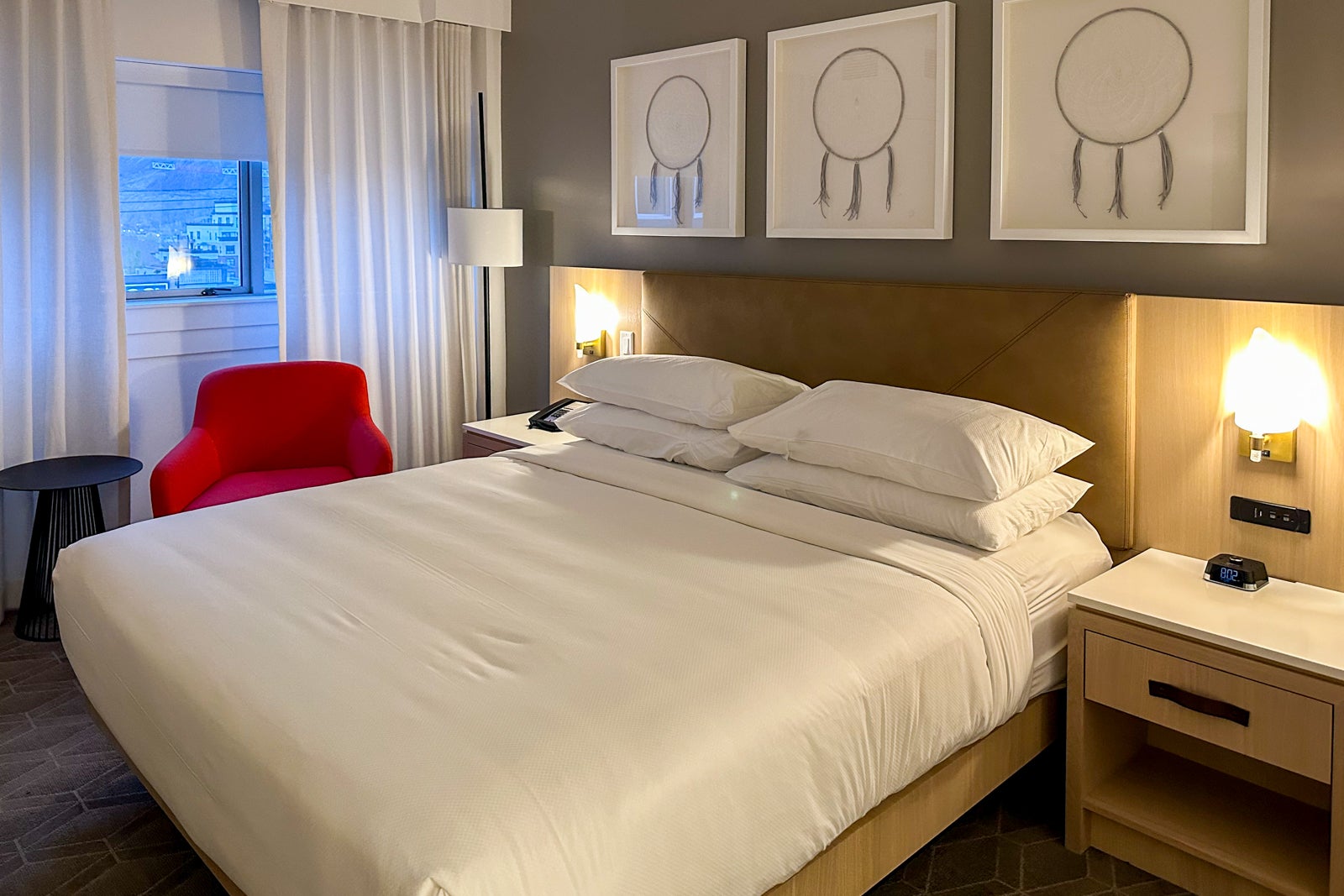
Unfortunately, the hotel I stayed at in Glenwood Springs did not meet the high standard set on board the train. Rocky Mountaineer partners with three hotels in Glenwood Springs: Hotel Colorado, The Hotel Denver and Glenwood Hot Springs Lodge. We stayed at the lodge, which was dark and dated.
Regardless of where you stay during an overnight with Rocky Mountaineer, one knockout service remains the same: Your luggage, aside from any hand baggage you keep with you on the train, is driven ahead and placed in your hotel room before your arrival. You'll even be checked in and given keys to your room before leaving the train.
Related: 9 mistakes travelers make on their 1st train trips
Of course, sometimes choosing one trip or another comes down to cold hard cash. Rocky Mountaineer's shortest First Passage to the West journeys, like the one I experienced last month, start around $1,500 per person this year, based on double occupancy. Upgrading to GoldLeaf service would mean starting rates closer to $2,100 per person. Entry-level two-day journeys on the Rockies to the Red Rocks route are similarly priced at $1,400 per person — or closer to $1,980 for SilverLeaf Plus.
In both instances, you can expect to spend about $500 more per person for Rocky Mountaineer's most premium services. With that in mind, the GoldLeaf service feels like a far better use of that extra cash compared to the SilverLeaf Plus product. But entry-level fares on both routes are comparable, meaning travelers should think closely about the scenery and the destinations along the route, including your departure city, arrival city and the whistle-stop.
However, travelers may also gravitate toward the more social, old-timey atmosphere in the SilverLeaf Plus lounge cars.
Traveling with Rocky Mountaineer isn't cheap, particularly when you consider you're on your own for dinner during the whistle-stop. Travelers might liken a journey with Rocky Mountaineer to an all-inclusive stay at a luxury hotel, or even a safari experience. But typically, three daily meals will be included, and the level of luxury will be consistent. The hotels you'll find in Kamloops and Glenwood Springs are far from the luxury you might expect from a $1,500-per-night resort. Many of our favorite all-inclusive resorts on the planet , in fact, are more affordable, and those prices are based on double occupancy.
Since Rocky Mountaineer's prices are per person, a couple can expect to spend upward of $3,000 per person for the two-day journey.
Rocky Mountaineer's pricing becomes much more palatable if you take advantage of the numerous discounts and promotions offered throughout the year. With one of its current promotions (available through June), you can save $780 per couple on Canadian routes and $1,000 per couple on the Rockies to the Red Rocks itinerary.
If these prices are still too eye-watering, travelers can experience the romance of the rails on board a more affordable, no-frills passenger train like Amtrak in the U.S. (the California Zephyr route will trace the same line from Denver to Glenwood Springs, though it concludes in San Francisco instead of the red-rock country of Utah). You'll be on your own for food, of course.
In Canada, Via Rail offers a 20-hour trip between Vancouver and Jasper, Alberta (where onward connections to Banff are available by bus). Travelers can choose from a standard economy fare, an individual sleeping berth or splurge on a private sleeper cabin with three square meals included — the latter of which can easily cost more than a journey with Rocky Mountaineer. Another consideration is that you'll miss an entire day's scenery since Via Rail travels overnight. It's a more expeditious trip, and for travelers in economy, it can certainly be a more affordable option.
Unlike Via Rail and Amtrak, Rocky Mountaineer journeys are far more focused on maximizing the scenery. Since the train only operates during the day, you won't miss a moment. And with its skilled, amiable onboard hosts to provide context and anecdotes, and the train cars designed for enjoying sweeping vistas, it's more like a tour than a mode of transportation.
Bottom line
Though we've only highlighted two of Rocky Mountaineer's routes here, travelers could also book itineraries that originate in, or depart from, Jasper, or extend their trips with packages that include bus transport to nearby destinations and attractions.
Whatever you do, remember to put down your phone – or even your book — and take a look outside the window, whether you're in a glass-domed GoldLeaf car, lounging around with other travelers or standing outside on a viewing platform. After all, taking time to slow down and enjoy the scenery is what rail travel is all about.
Related reading:
- Key travel tips you need to know — whether you're a beginner or expert traveler
- The best travel credit cards
- The 18 best places to travel in 2023
- 8 of the best credit cards for general travel purchases
- 13 must-have items the TPG team can't travel without
The Rocky Mountaineer Train
The Rocky Mountaineer showcases rugged alpine terrain and wildlife you can only see by rail, paired with comfy carriages, exquisite meals and excellent service. We'll help you choose the right train trip, then personalize your time in the Canadian Rockies . Luxury, scenery and a dash of adventure? It’s truly the trip of a lifetime.
Table of contents
Popular rocky mountaineer train trips in 2023, rocky mountaineer - fact sheet, maps of rocky mountaineer train routes, the rocky mountaineer service levels, rocky mountaineer goldleaf vs silverleaf service, rocky mountaineer usa vs canada train rides, rocky mountaineer train experience add-ons, frequently asked questions.
Canada's iconic daylight train only travels from sunrise to sunset. With routes to Banff, Jasper, Lake Louise, Kamloops, Whistler and Vancouver, you'll enjoy spectacular views and impeccable service along the way.
The travel experts at Canadian Train Vacations have extensive experience booking tours on the Rocky Mountaineer train routes. They can ensure your itinerary is a perfect match for your interests. When you book with us, you can add tours and excursions to the beginning or end of a trip, resulting in a completely customized travel experience. We offer friendly service and act as your point of contact from the time you start planning your trip until the very last day of your train tour.
Our Canadian travel experts recommend the following Rocky Mountaineer tour packages to travellers looking for a truly luxurious train experience.

Keep reading or chat with one of our local travel experts. We’re passionate about Canada and can help you at any stage of your vacation planning.
Complete Canadian Rockies by Rail
See all the highlights of the Canadian Rockies, from Banff and Jasper National Parks to the sparkling waters of Lake Louise. The Complete Canadian Rockies by Rail itinerary departs from Vancouver and includes two days of train travel.
Miles on train : 559 Miles
Days on train : 2
Train Stops: Vancouver, Kamloops, and Jasper
Discover Whistler and the Canadian Rockies by Rail
A popular route for photography buffs, Discover Whistler and the Canadian Rockies by Rail takes travellers from Vancouver all the way to Calgary, with train and transfers. Take a scenic tour of Icefields Parkway, walk on a real glacier, spend time in an alpine village or customize your tour with extra activities in Banff National Park or Jasper National Park.
Miles on train : 707 Miles
Days on train : 3
Train Stops: Vancouver, Whistler, Quesnel, and Jasper
Essential Rockies by Train
For travellers interested in a shorter trip, Essential Rockies by Train lets you soak up the splendour of the Canadian Rockies on a quick excursion. You'll see wildlife, glaciers and waterfalls as you travel through the mountain ranges of Alberta and British Columbia.
Miles on train : 594 Miles
Stops: Vancouver, Kamloops, Banff and Lake Louise
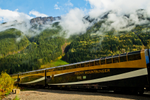
- The Rocky Mountaineer connects British Columbia and Alberta, with stops in Jasper, Lake Louise, Banff, Vancouver, Whistler, Quesnel and Kamloops.
- The train runs from mid-April until mid-October.
- The Rocky Mountaineer is a daylight-only train designed so that passengers can experience the most spectacular views and optimal photo opportunities.
- The routes are designed with an overnight break about mid-way, where guests are transferred to a comfortable hotel.
- Chef-prepared meals and local BC wines are included on the train, as well as gourmet snacks.
- Inside Rocky Mountaineer train cars , you'll find comfortable seats and friendly hosts who are ready to answer your questions and point out landmarks along each route. Glass domes give passengers a bird's-eye view of waterfalls, lakes, glaciers and wildlife. Each train also has an outdoor viewing platform, making it easier to see local points of interest.
- The best time of year to ride the Rocky Mountaineer depends on what you want to see. Late September is the best time if you want to view stunning fall foliage, while May is the best time to avoid summer crowds.
Download a brochure
Get inspired with sample itineraries, train information, route maps, and travel advice from our local experts.
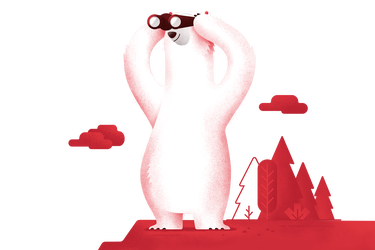
Rocky Mountaineer offers three stunning daylight routes connecting British Columbia and Alberta. We can personalize your trip around one of these train journeys or combine them together. Consult the map of your Rocky Mountaineer route for more information about what stops are included on each itinerary.
First Passage to the West
This route connects Vancouver and Banff and is the line the company first established when it was founded in 1990. The Rocky Mountaineer is the only passenger train to travel along this famous, historic section of the Canadian Pacific Railway . Memorable spots along the way include the charming train station at Lake Louise, the Stoney Creek Bridge, the dramatic Fraser and Thompson River Canyons and the location where the last spike was added to the railway in 1885.
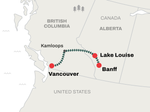
Route map: Rocky Mountaineer’s First Passage to the West train trip
Journey Through the Clouds
This route traverses the later of the two main Canadian transcontinental railways: The Canadian Northern Line, which dates to 1917. It travels between Jasper and Vancouver, taking the breathtaking Yellowhead pass through the mountains. The highlight of the trip is the view of snow-covered Mount Robson, the highest peak in the Rockies.

Route map: Rocky Mountaineer’s Journey through the Clouds train trip
Rainforest to Gold Rush
This route connects North Vancouver and Jasper, with stops in Whistler and Quesnel. The train passes through the Fraser River Canyon. This routing was previously known as the "Fraser Discovery Route," and much of the hosts’ involve the discovery of British Columbia's wild timber country and Gold Rush history. It's not uncommon to spot black bears, bald eagles, osprey and even grizzly bears.
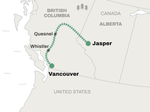
Route map of Rocky Mountaineer’s Rainforest to Gold Rush train trip
#1 Travel tip: Longer train route
Choose Rocky Mountaineer’s Rainforest to Gold Rush route from Vancouver to Jasper if you’d like more time on the train. It takes 2.5 days and has 2 overnight stops.

Download our Brochures and Mini Guides
Rocky Mountaineer offers two enticing service levels — Goldleaf and Silverleaf — with features that appeal to every traveller. We can help you decide which service level is right for you.
GoldLeaf Service
On GoldLeaf, you can take in Canada's iconic landscape from a bi-level glass-dome luxury coach. During meals, you’ll feast on gourmet creations by Executive Chefs.
The GoldLeaf cars are double-level, and your assigned seat will be on the top floor, right underneath the dome window where you will have 360-degree views of the scenery around you. Downstairs is the dining room, where you will be served a la carte meals prepared onboard. GoldLeaf cars also feature an outdoor viewing platform where you can step outside for some fresh mountain air.

SilverLeaf Service
Winding through the Canadian Rockies onboard a luxury coach, you'll come face to face with magnificent scenery. It can be so breathtaking, you may think you’re dreaming.
Hot gourmet breakfasts and lunches served at your spacious seat means you won't have to miss a moment of the splendour out your window. Nor will you miss a moment of the latest historical tidbit from your onboard Host. SilverLeaf cars also feature outdoor vestibules between the cars where you can step outside and feel the cool mountain breeze on your face.

Which is the best option for your Canadian train getaway? To help you decide which level of service is perfect for you, here’s a quick comparison between GoldLeaf and SilverLeaf.
Both SilverLeaf and GoldLeaf include:
- complimentary alcoholic and non-alcoholic beverages
- entertaining commentary
- baggage handling in Kamloops and Quesnel
The Rocky Mountaineer does operate daylight sightseeing trains in both the USA and Canada.
In the USA, the Rocky Mountaineer only has one rail route, which travels between Moab, Utah, and Denver, Colorado. There is an overnight stop in Glenwood Springs.
In Canada, the Rocky Mountaineer has three routes through the Canadian Rockies, between British Columbia and Alberta. You can go from Vancouver to Banff, Jasper, or Lake Louise. Overnight stops are in Kamloops, Quesnel, and Whistler (depending on the route). A benefit to taking the Rocky Mountaineer in Canada is the multiple options to choose for your train trip. Our Circle the Canadian Rockies by Train trip combines two Rocky Mountaineer journeys for an epic roundtrip train tour.
Difference in Service Levels
On the Rocky Mountaineer Colorado to Utah, there are two levels of service — SilverLeaf and SilverLeaf Plus. SilverLeaf Plus includes exclusive access to a separate lounge with upscale drinks and an elevated food experience. SilverLeaf Plus is only available on this USA route. There is no GoldLeaf class on Rocky Mountaineer train trips USA.
If you want to experience the ultimate in rail luxury in North America, you need to take a Rocky Mountaineer trip in GoldLeaf through Western Canada. GoldLeaf is the most luxurious service and includes a seat in a bi-level glass-dome car with oversized windows. GoldLeaf has a separate dining area on the lower level where you can enjoy your freshly prepared gourmet meals.
SilverLeaf class in Canada and USA is the same. SilverLeaf includes a seat in a single-level dome car with beautiful views. Regionally inspired meals and drinks are served at your seat.
Destinations
On Colorado Rocky Mountain train rides, you’ll see desert canyons, sandstone archways, rock formations, and the Colorado River.
In Canada, the Rocky Mountaineer takes you to Banff and Jasper national parks. You’ll travel through dramatic canyons and mountain passes, past rushing waterfalls and coastal rainforests. The Rocky Mountaineer train journeys in Canada are longer than those in the USA, meaning you have more time to relax and gaze at the ever-changing scenery.
Once you’ve arrived in the Canadian Rockies, there are many impressive sights to explore on day trips and excursions. Cruise on Maligne Lake in Jasper, tour the famous Icefields Parkway, ride the Banff Gondola, or have afternoon tea at Chateau Lake Louise. You could even experience a thrilling helicopter tour over ancient glaciers, towering peaks, and turquoise lakes.
Alaska Cruise
The rail portion of your trip can come before or after your Alaska cruise. A smaller ship allows you to visit more coves and inlets, and offers a more immersive experience in the area. Ask your travel advisor about adding a cruise to your Rocky Mountaineer trip. It involves an easy flight from Vancouver to the port of departure.
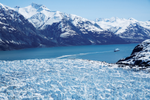
Floatplane Sightseeing
For an extra dose of adventure, hop on a floatplane and glide over Vancouver's skyline or the natural wonders of Whistler in British Columbia. Floatplanes take off from and land on the water, putting you right in the middle of the action.
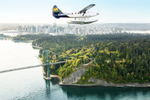
Helicopter Tours
Enjoy 360-degree views of the Canadian Rockies while sightseeing via helicopter. You'll gain a new appreciation for Canada's natural beauty as you hover above lakes, rivers and waterfalls. You may even get a glimpse of the local wildlife.
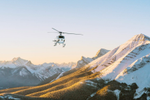
#2 Travel tip: Wildlife viewing
Rocky Mountaineer hosts will make announcements for wildlife sightings and the train will slow down, giving you the opportunity to get your camera ready or head to the outdoor platform.

Places to Visit
From the shimmering waters of Vancouver to the fresh mountain air of Jasper, the Rocky Mountaineer train travels through many of Canada's best scenery and cities. Your Canadian Train Vacation Advisor can help personalize a trip for you that includes the best places to visit in Western Canada. Our Rocky Mountaineer rail packages may include stops in the following places.
Vancouver
All of the Rocky Mountaineer trips in Canada start or end in Vancouver. This West Coast city is a popular summer destination due to its mild climate. It's warm, but not so warm that you'd rather spend your whole vacation indoors. Vancouver blends world-class restaurants and cultural attractions with soaring mountains and outdoor activities — everything from easy paddles to challenging hiking trails, giving every traveller something fun to do.
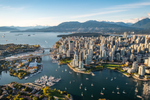
Jasper
If you want to spend your vacation relaxing, Jasper is the perfect destination. It's a sleepy mountain town with plenty of places to rest after a morning of paddling, hiking or sightseeing. It’s home to inviting bakeries and a brewpub, as well as several nice dining establishments.

Banff
Located in Alberta, Banff is home to Banff National Park, one of Canada's most popular attractions. The town itself is filled with restaurants and shops, but the nearby national park offers tempting outdoor activities for nature enthusiasts. If you visit Banff National Park, you'll see lakes, waterfalls, glaciers and mountain peaks.
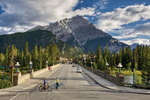
Lake Louise
Crystal-clear water and stunning glacier peaks are just a few of the many reasons to visit Lake Louise. Paddling enthusiasts flock to the lake during the summer months, but Lake Louise has year-round outdoor activities.
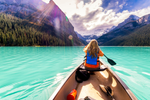
Whistler
Whistler, British Columbia, has fine-dining establishments, trendy shops and other amenities to make your visit to the Canadian Rockies a memorable one. Relax at a local spa or play a round of golf while you're in town. One of Whistler's most popular attractions is the Peak 2 Peak Gondola, which links Roundhouse Lodge with Rendezvous Lodge. The Rocky Mountaineer only runs in the warmer months, but Whistler is a famous ski destination.
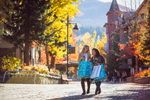
Kamloops
Originally settled by the Shuswap First Nation, Kamloops is a popular stop on several Rocky Mountaineer train routes. Travellers enjoy visiting local wineries and viewing wildlife at BC Animal Park. The stop here on your Rocky Mountaineer trip is a quick overnight visit. You’ll see most of the sights from the train.
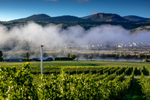
Quesnel
Nestled between Prince George and Williams Lake, Quesnel is a popular stop on the route through British Columbia to the Yukon. Outdoor enthusiasts flock to Quesnel for some of the best fishing, hiking and canoeing in the world. Like Quesnel, the stop here on your Rocky Mountaineer trip is a quick overnight visit. You’ll see most of the sights from the train.

What Our Customers Say
The rocky mountaineer exceeded my expectations.
Getting off the train at Winnipeg to temperature of –2 with a wind chill taking it down to –9 and snow! The hotel was outstanding despite the 12 hour delay to the Via rail train an... read more
![rocky mountaineer side trips Ian and Gareth review of their [object Object] trip](https://cdn.bfldr.com/UAHFH8T4/as/99xvxhfnjn5cpm9w7k3mrk3k/Ian_Gareth_234?auto=webp&format=webp&width=75)
Ian and Gareth
Like clockwork from start to finish
We had a wonderful trip. Everything went according to the schedule, all pick-ups and drop-offs went like clockwork. Hotels were as described, some absolutely fabulous, for example... read more
![rocky mountaineer side trips Christine and Douglas review of their [object Object] trip](https://cdn.bfldr.com/UAHFH8T4/as/n89hrn9pgv36nbn3x79rnqb/Christine_Douglas_100?auto=webp&format=webp&width=75)
Christine and Douglas
The natural beauty of the Canadian Rockies amazed us
The natural beauty of the Canadian Rockies amazed us. We thoroughly enjoyed our dinner in Vancouver while watching float planes take off and land. The Rocky Mountaineer provided us... read more
![rocky mountaineer side trips Larry and Myra review of their [object Object] trip](https://cdn.bfldr.com/UAHFH8T4/as/rvpbtb9kw5vb6st4q9sjk4jp/Larry_Myra_529?auto=webp&format=webp&width=75)
Larry and Myra
Rocky Mountaineer portion was the best part of our trip
Rocky Mountaineer portion was the best part of our trip. We loved the food, scenery, and the story telling by staff and fellow travelers.
![rocky mountaineer side trips Donald and Jenny review of their [object Object] trip](https://cdn.bfldr.com/UAHFH8T4/as/gv5n4m4bcbrvf4rcvvqxbrbn/Donald_Jenny_534?auto=webp&format=webp&width=75)
Donald and Jenny
The scenery was beautiful
Rocky Mountaineer was great (people and food). The scenery was beautiful. Everyone remembering our anniversary and personalizing it with cards and small gestures was special. The g... read more
![rocky mountaineer side trips Bob and Judy review of their [object Object] trip](https://cdn.bfldr.com/UAHFH8T4/as/mj4vxhrf39z5z5jppvm3zs/Bob_Judy_556?auto=webp&format=webp&width=75)
Bob and Judy
Why book your luxury rail trip with Canadian Train Vacations?
We take care of all the details
You want to relax and enjoy your trip, not get overwhelmed by the planning. Let us make all of the bookings for you, including rail tickets, hotels, excursions and activities, meals and transfers.
Independent travel with expert support
Enjoy local expertise and guidance with a personalized itinerary. Your preferences and needs are our priority. We take care of you from the moment you land until the moment you leave.
Get help when you need it
You’ll receive the inside scoop before you even leave home. And you can relax during your vacation because we’re only a phone call away if you have any questions while you’re in Canada.
What is the Rocky Mountaineer?
The Rocky Mountaineer is a train company offering luxury sightseeing tours in Western Canada and the American Southwest. Each route features panoramic views of the Rocky Mountains, comfortable seating and delicious meals prepared with fresh local ingredients.
Who owns the Rocky Mountaineer?
Armstrong Hospitality Group, owned by Peter Armstrong, operates the Rocky Mountaineer luxury train company.
How long is the Rocky Mountaineer train ride?
Rocky Mountaineer train tours typically include 2 to 5 days aboard a rail route and 1 to 2 nights in a hotel. It's possible to extend your trip by adding tours and excursions at the beginning or end of your Rocky Mountaineer train ride.
How much does a Rocky Mountaineer train trip cost?
Rocky Mountaineer train prices vary based on the length of your trip and whether you purchase any add-ons. For a standard trip with no extra tours or excursions, our Rocky Mountaineer train trips range from $3,590 USD to $6,780 USD.
Where does the Rocky Mountaineer train start and end?
All Canadian Rocky Mountaineer train journey begin or end at the Rocky Mountaineer train station in Vancouver. The other end-point depends on which route you select. For the First Passage to the West itinerary, it’s Banff/Lake Louise, while for the Journey Through the Clouds and Rainforest to Gold Rush Rocky Mountaineer train routes end it is Jasper.
Is Rocky Mountaineer GoldLeaf worth it?
Rocky Mountaineer train holidays offer two levels of service: SilverLeaf and GoldLeaf. Although SilverLeaf service includes gourmet meals, panoramic views and personal attention from the tour hosts, GoldLeaf service comes with some extra-special touches that make it well worth the price. GoldLeaf passengers enjoy spacious seats in the upper level of the glass-domed coach and chef-prepared meals featuring local ingredients.
Does the Rocky Mountaineer run in winter?
Rocky Mountaineer train tours aren't available during the winter. The company runs its luxury train excursions from April through October of each year.
Can you sleep on the Rocky Mountaineer?
Rocky Mountaineer train rooms aren't available to passengers. The train only operates during daylight hours, so trips with overnight stops include hotel accommodations. Reservations at a midpoint hotel come standard with each train tour, but passengers have the option to upgrade their hotels on some routes.
What is the most scenic route on the Rocky Mountaineer?
First Passage to the West is one of the best Rocky Mountaineer scenic routes because it takes passengers through the historic Spiral Tunnels and provides sweeping views of the Canadian Rockies. For even more scenery, pair the First Passage to the West itinerary with another Rocky Mountaineer route on a Circle Tour.
Which is better, VIA Rail or Rocky Mountaineer?
VIA Rail and Rocky Mountaineer both offer quality train service in Canada, but Rocky Mountaineer is a better pick for travellers interested in having a luxury experience in the Rockies.
Where in America can you catch the Rocky Mountain train?
You can catch the Rocky Mountaineer train from Moab in eastern Utah or from Denver, the capital of Colorado. The Rocky Mountaineer Denver to Moab train route is a two-day journey between these cities. You stop in Glenwood Springs overnight.
About the author: Katherine is Product Manager with Fresh Tracks Canada. Having worked in the Canadian travel industry for almost 20 years, she enjoys sharing her local expertise with visitors. She is based in Calgary and one of her favourite Canadian destination is the... Read more
Explore More Tours
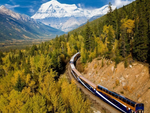
Discuss your Canadian train vacation with a local travel expert
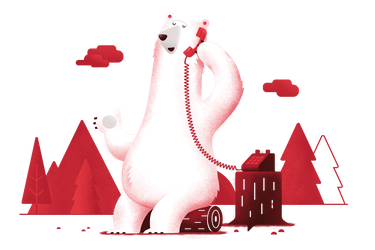
Or call us toll free
Current promotions
Sign up for special offers, monthly Canadian Insider tips, and vacation inspiration.
- Search Please fill out this field.
- Manage Your Subscription
- Give a Gift Subscription
- Sweepstakes
- Bus and Train Travel
I Took the Rocky Mountaineer's Newest Train Route From Colorado to Utah — Here's What It Was Like
The Rocky Mountaineer launched the Rockies to Red Rocks route in August.
Jessica Poitevien is an international storyteller and regular contributor to Travel + Leisure.
:max_bytes(150000):strip_icc():format(webp)/Jessica-Poitevien-2cbdf969757d480cb8b287cf97d1b882.jpg)
As the morning sun peaked behind the Rocky Mountaineer train, I could tell that my fellow passengers and I were in for a treat. There wasn't a cloud in the sky, so views from the train, with its dome-like sightseeing cars, were bound to be impressive. After all, the jaw-dropping vistas are the main highlight of the Rocky Mountaineer's newest route between Denver, Colorado, and Moab, Utah.
Aptly named Rockies to the Red Rocks , this route is the first U.S. itinerary for the Canadian rail company. It also marks the first time a passenger train has made its way to Moab. These major milestones, along with the grandeur of the route's ever-changing landscapes, drew train buffs from near and far clamoring for a chance to be among the first passengers to ride these rails.
I met folks who had ridden the Rocky Mountaineer several times in Canada, another who explored Japan's high-speed rail system, and even a passenger who spent two weeks on the Trans-Siberian Railway, the longest railway line in the world. Despite our varying levels of train travel experience and expertise, however, we still came to the same conclusion: the Rockies to the Red Rocks experience is not one to miss.
As the train pulled out of Denver for the beginning of our two-day adventure, I settled into my assigned seat. Knowing that I would be on the train for eight hours on day one and five hours on day two, I was happy to find that I had plenty of legroom. My seat could also slide forward to create the effect of reclining without bothering the person behind me — the first of many thoughtful touches I'd experience during my journey on the Rocky Mountaineer.
My favorite feature, however, was the design of the windows, which extended toward the top of the car, allowing for nearly unobstructed views. For the moments that I wanted to feel the crisp autumn air, I went to the vestibule between train cars, where an open window allowed me to poke my head out — safely, of course — and fully immerse myself in the passing scenery. Though the Coloradans on board claimed we were past peak fall foliage, traveling at the end of October (the route typically runs April through November) meant finding trees still colored with bright yellow and deep red leaves, while snow-capped mountains loomed in the background.
We spent two days on the train, with an overnight stay at a hotel in Glenwood Springs, Colorado — home to the world's largest mineral hot spring pool. The hotel stay is part of the Rockies to Red Rocks package, and guests can choose the property that best fits their budget. Since the Rocky Mountaineer is all about top-notch service, we all received our hotel room keys before disembarking and found our luggage waiting for us inside our accommodations. In Glenwood Springs, I took a dip in the hot springs pool, enjoyed dinner at Riviera Supper Club and turned in well before my usual midnight bedtime, knowing we had an early morning wake-up call.
Day two started with watching the sunrise over the mountains and Colorado River. Traveling on the Rocky Mountaineer only during daylight hours meant we always had stunning views to enjoy. Throughout most of the journey, we snaked alongside the Colorado River, watching steam rise when the water was warmer than the temperature outside. My eyes remained glued to the windows, admiring the constant changes in geology and natural color palettes as we passed from dense, green forests to the more bare Rocky Mountains, and eventually the red and brown hues of the buttes and mesas. I also kept my eyes peeled for wildlife like elk, moose, black bears, bald eagles, and ospreys.
Though the scenery was awe-inspiring on its own, what really made it come to life was the colorful storytelling of the staff on board the train. A team of four crew members took care of our train car. Beyond providing us with snacks, coffee breaks, alcoholic beverages, and delectable meals like the coriander-crusted salmon I had for lunch on day one, the crew also entertained us with stories. Along the way, we heard about the history, both past and present, of the communities we passed through, along with some personal anecdotes from the mostly Coloradan crew. Ask me about the endearing tale of where our main storyteller, Mike, had his first kiss, and I could still recite it by memory.
Both the storytelling and service were superb, and since I was seated in the SilverLeaf Plus class, I also had access to a separate lounge car, where even more drinks and snacks were served alongside cozy seating for enjoying the views.
The trip ended in Moab, surrounded by the red rocks that helped named this route. Though the train portion of the trip was over, the adventures were not. Guests have the option of organizing post-trip (or pre-trip if they start in Moab) tours to explore the many offerings in the area. That includes Utah's Mighty Five national parks: Arches, Bryce Canyon, Canyonlands, Capitol Reef, and Zion. Moab also offers thrilling off-road jeep experiences with companies like Outlaw Adventure Tours and mesmerizing stargazing with Moab Astronomy Tours .
Whether you're a seasoned train traveler or new to the experience, an adventurer or someone who likes to admire Mother Nature from afar, the Rocky Mountaineer really offers it all. With the success of this first route, I wouldn't be surprised if the Rocky Mountaineer expands its U.S. footprint, and I, for one, will be among the first to try any itinerary this company creates.
Travel Observations
Thoughtful trips for discerning travelers.

How to Choose a Rocky Mountaineer Train Route

Which Rocky Mountaineer Route to Choose?
So you’re ready to book a trip on the Rocky Mountaineer train and you’re dreaming of that amazing scenery, all-inclusive food and drink, wonderful narrating hosts, and spectacular domed views…. But how do you actually pick which itinerary or route? Choosing a Rocky Mountaineer route is one of the first steps to creating your perfect luxury train vacation!
Here are some hints to help you – and I encourage you to work with a Rocky Mountaineer Specialist like myself who can really make sure you’re getting the most from your investment into this amazing train ride!
Three Rocky Mountaineer Train Routes
There are three main train routes that take you across the gorgeous Canadian Rockies. They can often be combined in different ways, so it’s important to start to think about your wish-list for this vacation. For instance, if you definitely want to spend time in the Jasper area, you need to choose a route that starts or end in Jasper, as not all of them do.
All Rocky Mountaineer itineraries can be reversed – you can choose to do train first or train last. If you fly into Calgary, you will do the “non train” portion first. If you fly into Vancouver, you will do the train first.
First Passage to the West (Vancouver to Banff or Lake Louise)
The two-day First Passage to the West route rolls along the historic tracks of the country’s first coast-to-coast railway between Vancouver and Banff or Lake Louise, with an overnight stay in Kamloops.
Pass by the snarling rapids of Hell’s Gate—named for explorer Simon Fraser’s assertion that “surely these are the gates of Hell”—and the twin rail bridges of Cisco Crossing. Between Kamloops and Banff, you’ll witness the site of the “last spike” driven into the Canadian Pacific Railway in 1885 at Craigellachie, and experience the engineering marvel of the Spiral Tunnels. As you travel through Banff National Park be awed by views of towering Castle Mountain and Mount Rundle.
Choose this route if: You want to spend a lot more time in the Banff/Lake Louise area (they’re very close to each other) and you won’t be going up to Jasper at all. Hint: If you get a late afternoon flight out of Calgary for your departure, you can spend your last day in Banff and still make it to the airport on time, rather than transferring back to a Calgary hotel the night before.
Journey Through the Clouds (Vancouver to Jasper)
Also two days long, Journey through the Clouds travels between Vancouver and Jasper, traversing some of the most remote landscapes in Canada, with scenery and wildlife largely untouched by humans. Like First Passage to the West, the rail route passes the rushing Hell’s Gate and Cisco Crossing, travelling along both the Fraser and Thompson rivers. Between Kamloops and Jasper, the train passes the glacier-fed, three tiered Pyramid Falls; Mount Albreda; and Mount Robson—the highest peak in the Canadian Rockies at 3,954 metres (12,972 feet). Mount Robson is so big that it often forms its own weather patterns, with clouds enveloping the peak while the rest of the sky is blue. Jasper National Park is a Dark Sky Preserve known for stargazing, wildlife around every corner and some of the best outdoor adventure in the Canadian Rockies.
Choose this route if: It’s a high priority to spend time in Jasper and to visit Jasper National Park, and if you’d like to stop at the Athabasca Glacier on the Columbia Icefields during the drive from Jasper to your next stop.
Insider trip: I recommend at least 2 nights in Jasper on this route so that you get at least one full day to explore. Travelers who are able to stretch to 3 nights in Jasper have thanked me profusely as well!
Check out this video of the route.
Rainforest to Gold Rush (Vancouver to Jasper via Whistler)
For those that want to delve further into Western Canada’s history and diverse landscapes—as well as spending more time on the train—the three-day Rainforest to Gold Rush route takes a northerly path between Vancouver and Jasper, uncovering the stories of those seeking their fortune. This rail route also boasts the most trestle bridges, making it a favorite with train fans. With overnights in Whistler and Quesnel, on this journey you’ll climb through rainforest into the alpine alongside the southern fjord of Howe Sound, pass the deep turquoise waters of Seton and Anderson lakes, travel along the desert like Cariboo Plateau, cross the historic Cottonwood River Bridge, and take in Mount Robson. With two of Western Canada’s best outdoor adventure hubs on this train journey, Whistler and Jasper, this rail route is the perfect fit if you love exploring nature.
Choose this route if: Spending a free afternoon in Whistler excites you, and you’re thrilled to spend 2.5 days on the train (remember, you don’t spend the night on the train!).
Circle Routes
These basically combine two rail routes to return to your original point of origin. This is ideal for returning clients who really want at least 4 days on the train itself. You may take the Rainforest to Gold Rush route first, for instance, then have some free time in Jasper and Lake Louise, then take the Journey Through the Clouds itinerary back to Vancouver from Lake Louise.
Still can’t decide on a Rocky Mountaineer Train Route?
If a luxurious train trip through the Canadian Rockies has been on your bucket list, but you’re not quite sure which to take, don’t worry! I’ve designed a short, fun quiz to help you decide what type of train trip you should take. Click below to get started!
Ready to turn your travel dreams into reality? Let me take care of the details and create a personalized itinerary just for you. Whether it’s a relaxing getaway or an adventurous expedition, I specialize in crafting unforgettable experiences. Contact me now to book your next journey and embark on a hassle-free adventure!
Share this:
Other articles you may enjoy.
Category: National Parks and USA , Trip Suggestions Tags: rocky mountaineer , trains , travel tips , trip ideas

Recent Articles
- How to Plan A Trip to the Algarve – Beyond the Beaches!
- 10 Things to Do In Budapest
- How To Stay Healthy While Traveling: 7 Tips To Help You Avoid Getting Sick
- Best Algarve Towns for History Lovers
- Eight Things To Do in Banff

Testimonials

An independent affiliate of Gifted Travel Network — a Virtuoso® Member
- Florida Seller of Travel Ref. No. ST39093
- California Seller of Travel No. 2113317-40
- Washington UBID No. 603 308 394

- [email protected]
- 412-203-4061
- Pittsburgh, PA || Accepting clients all over the USA

My latest articles
Copyright © 2024 · All Rights Reserved · Travel Observations
Swell Lite from Organic Themes · RSS Feed

Rocky Mountaineer Review – Everything You Need to Know
- Last Updated: January 13, 2023
Thinking about experiencing one of the world’s best train journeys? Have a read of our Rocky Mountaineer review to get an idea of what to expect along the way!
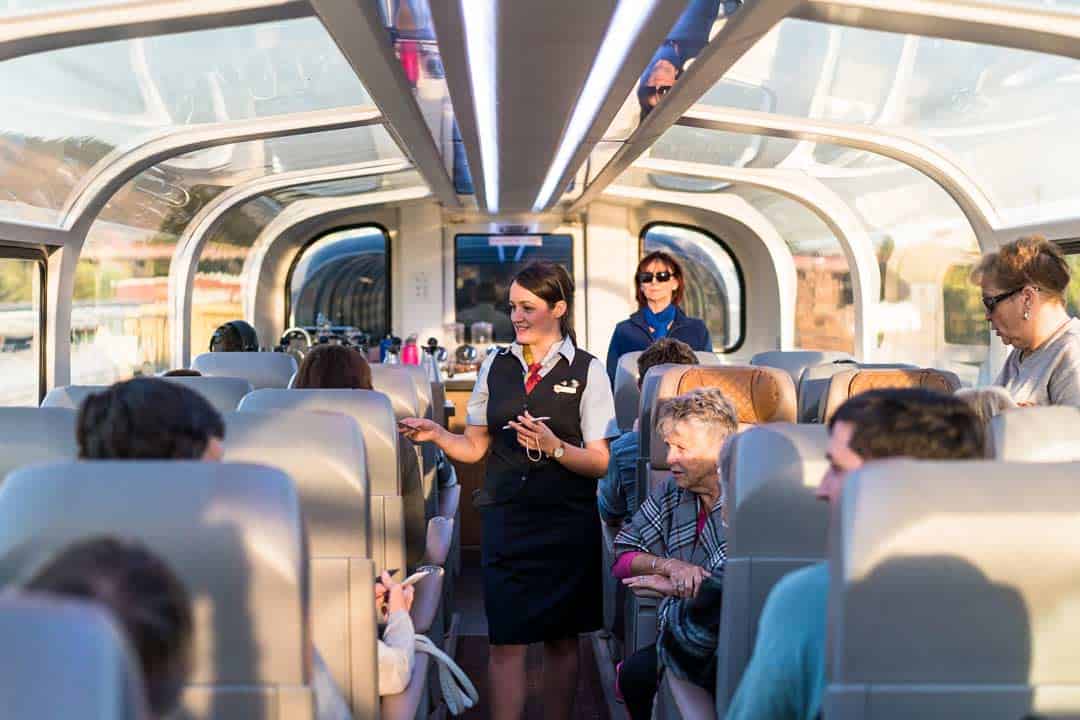
Snaking its way through the heart of the Canadian Rockies, the nation’s most luxurious and scenic train journey is an experience unrivalled in North America.
The pleasure of traversing the globe by rail has captured the hearts and dreams of travellers for years, and even though the modern age of cheap and fast flights has opened up destinations like never before, Rocky Mountaineer has embraced the slow, romantic travel that only a train trip can offer.
The family-run business has been operating majestic train journeys since 1990, and over the years their service has become synonymous with Canadian luxury travel.
Check out our Rocky Mountaineer photos for more travel inspiration.
It is one of the most sought-after experiences for many visitors to the Great White North, and for good reason. There is nothing quite like it anywhere else on the continent!
If you’ve been looking for some Rocky Mountaineer reviews to find out whether it’s the right trip for you, we hope this article helps answers your questions.
Table of Contents
The GoldLeaf Service Seats
The glass-dome ceiling, the outdoor viewing platform, rocky mountaineer hosts – the best in the business, the food on rocky mountaineer, accommodation, off-train excursions, rocky mountaineer review, rocky mountaineer review – unsurpassable luxury travel.
We joined the First Passage to the West, which traverses the classic route from Vancouver to Banff through the Continental Divide and into the spectacular ranges of the Canadian Rockies.
This particular journey is the most popular trip that Rocky Mountaineer offers, and it’s the one that most people have visions of when planning their own train adventure through Canada.
We travelled in GoldLeaf Service, Rocky Mountaineer’s premier class, and the epitome of luxury and quality in train journeys.
This is a two-day trip, with a night spent in comfortable accommodation in Kamloops along the way. You do not sleep on the train, but you do spend most of each day onboard.
As part of the experience Rocky Mountaineer took care of all the logistics for the journey, including hotels before, during and after the ride, and transfers between the stations and the accommodation.
Once you’re on board everything is all-inclusive, meaning except for any souvenirs you may choose to buy, you can leave your wallet in your pocket and enjoy the quality food, beverages and service that Rocky Mountaineer provides.
The First Passage to the West was the perfect introduction to luxury train travel in Canada, and it was our experience on this journey that we will be basing the first of our Rocky Mountaineer reviews on.
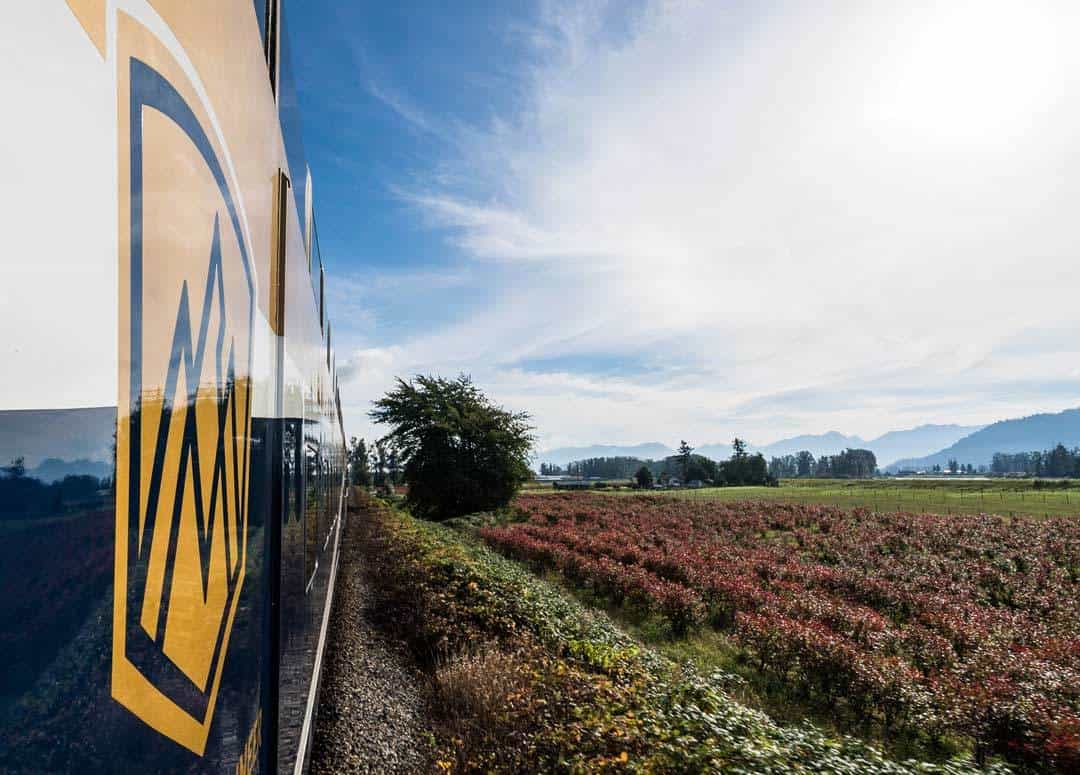
GoldLeaf Service vs SilverLeaf Service
There are two different types of services on board – SilverLeaf Service and GoldLeaf Service.
While they are both truly spectacular ways to travel across the Canadian Rockies, and offer a level of comfort that surpasses almost all expectations, the GoldLeaf Service has a few notable upgrades.
The main difference between the two is that SilverLeaf Service occupies a standard single-level carriage, while GoldLeaf Service has a premium and custom two-level carriage, complete with dining areas downstairs and a remarkable glass panorama ceiling upstairs that offers uninterrupted views of the surrounding landscape.
In SilverLeaf Service your meals are served directly to your seat, much in the same way as airlines, and both non-alcoholic and alcoholic beverages are complimentary.
In GoldLeaf Service the guests are split into two groups for mealtimes, which are held downstairs in a dedicated dining room.
This gives guests a true restaurant experience and ensures there is ample room to spread out and enjoy your courses.
Premium alcoholic beverages are included for GoldLeaf Service guests, and the meals are of higher quality.
Both services are amongst the best in the business, but truth be told there really is no better way to explore Canada’s west coast by rail than splurging out on the GoldLeaf Service.
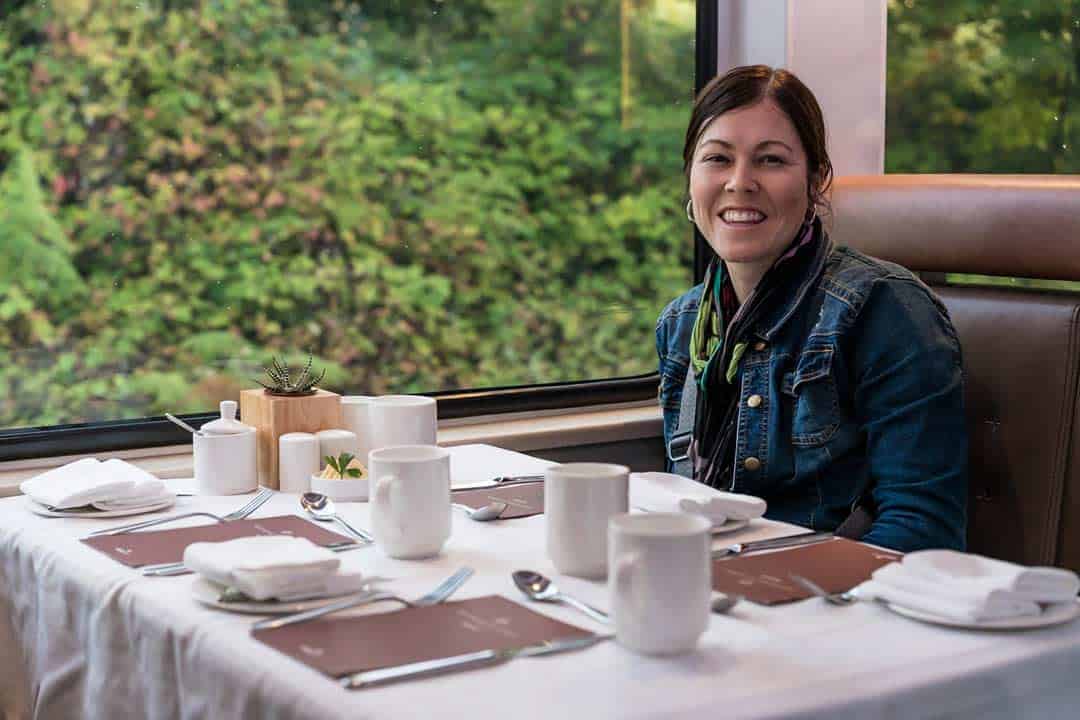
There’s one major problem with the seats in GoldLeaf Service – They are so comfortable it’s almost too easy to simply sit back and nap away the day!
Luckily the views are gorgeous and the hosts attentive, or there’d be a high chance you’d sleep through the whole journey.
The seats in Rocky Mountaineer’s GoldLeaf Service are of a calibre you’d expect to find in business class on the world’s best airlines.
The first thing you’ll notice is just how comfortable they are, with soft leather and plush padding allowing you to sink into their wide embrace.
The seats are also fully adjustable thanks to a customised electric system. At a push of a button you can recline fully back (while sliding into your own space so as not to encroach on the guest behind you), inflate the padding at the arch of your back, and raise the leg rests.
Our favourite feature of these armchairs though is the heated seats. If you’re feeling chilly you can turn these on and quickly warm up the lower part of your body.
The GoldLeaf Service seats really do take train comfort to another level.
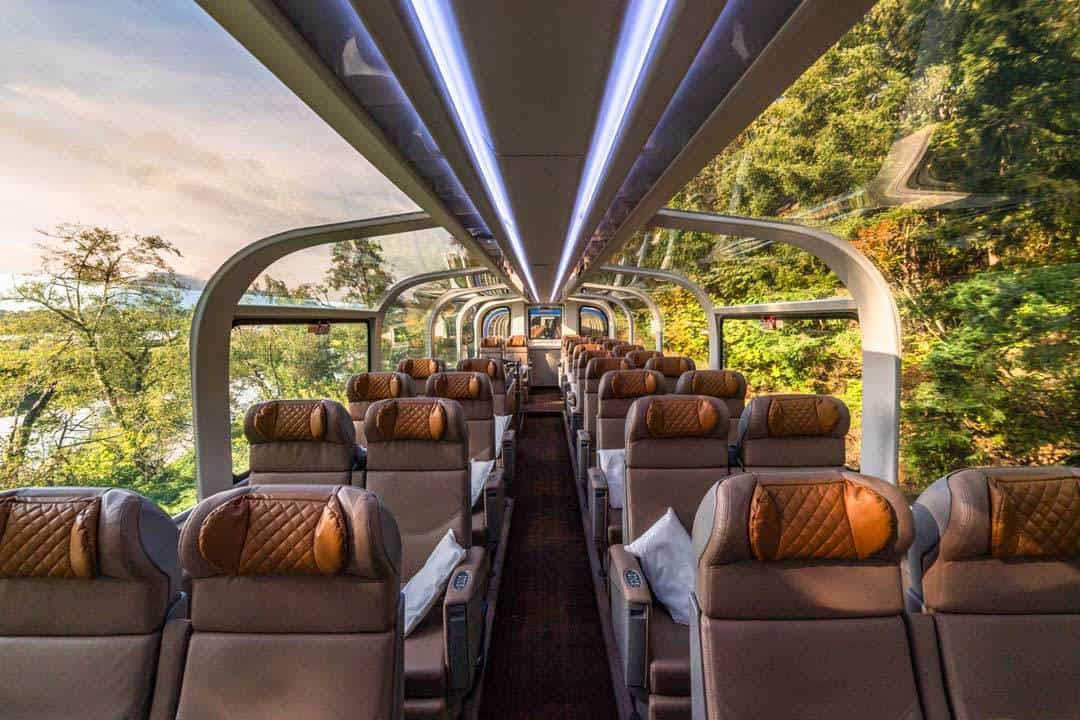
The most celebrated feature of Rocky Mountaineer’s GoldLeaf Service is the glass-dome ceiling, and this is what you’ll most likely remember the most.
Even though SilverLeaf Service offers huge visibility, in GoldLeaf Service Rocky Mountaineer really outdoes itself by doing away with the traditional ceiling and instead utilising a glass dome, giving unrivalled panoramic views as you travel through the Canadian Rockies.
Another thing that we couldn’t help but notice is that the elevated coach actually allows you to look over the pine trees and see the terrain beyond, rather than always trying to catch a glimpse between the foliage.
Being able to see the tops of the mountain peaks from your seat really does give you a unique perspective at just how enormous the landscape in Canada is.
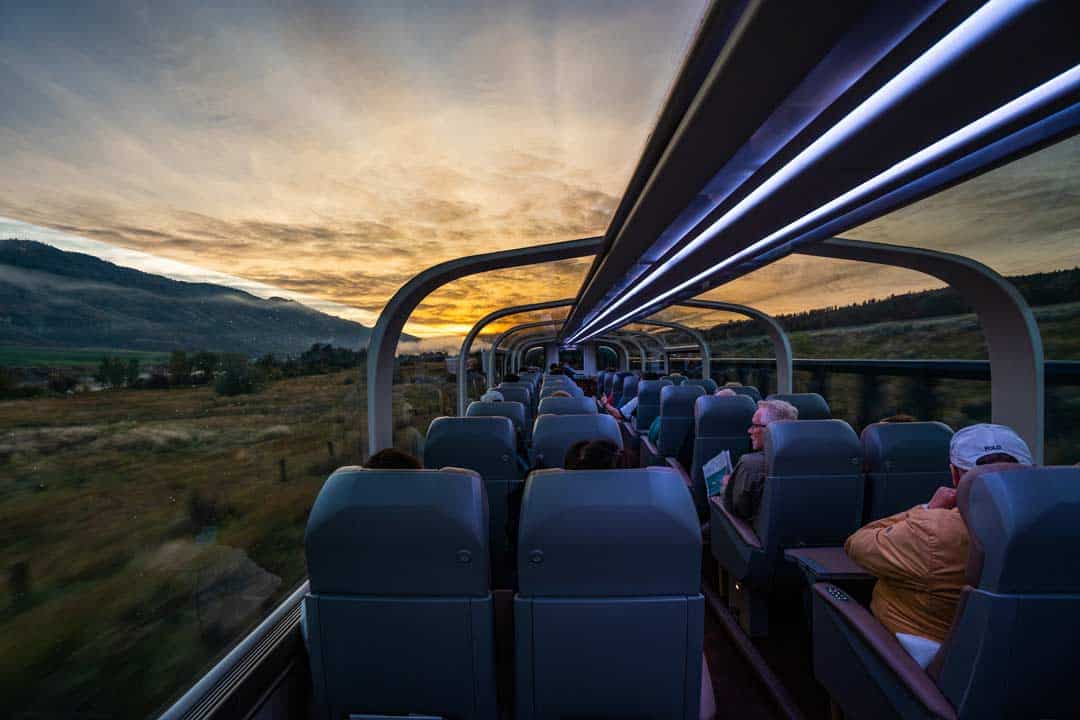
This was our personal favourite part of GoldLeaf Service and something that often gets overlooked in Rocky Mountaineer reviews.
At the back of each GoldLeaf Service coach is a spacious outdoor viewing platform that allows you to bask in the fresh air of the Rockies, and gives unhindered views across the terrain.
Whenever the hosts announced an upcoming highlight, such as Hell’s Gate in the Fraser Valley or passing by the Kicking Horse River, we’d head outside to try and capture perfect pictures and have an even better outlook.
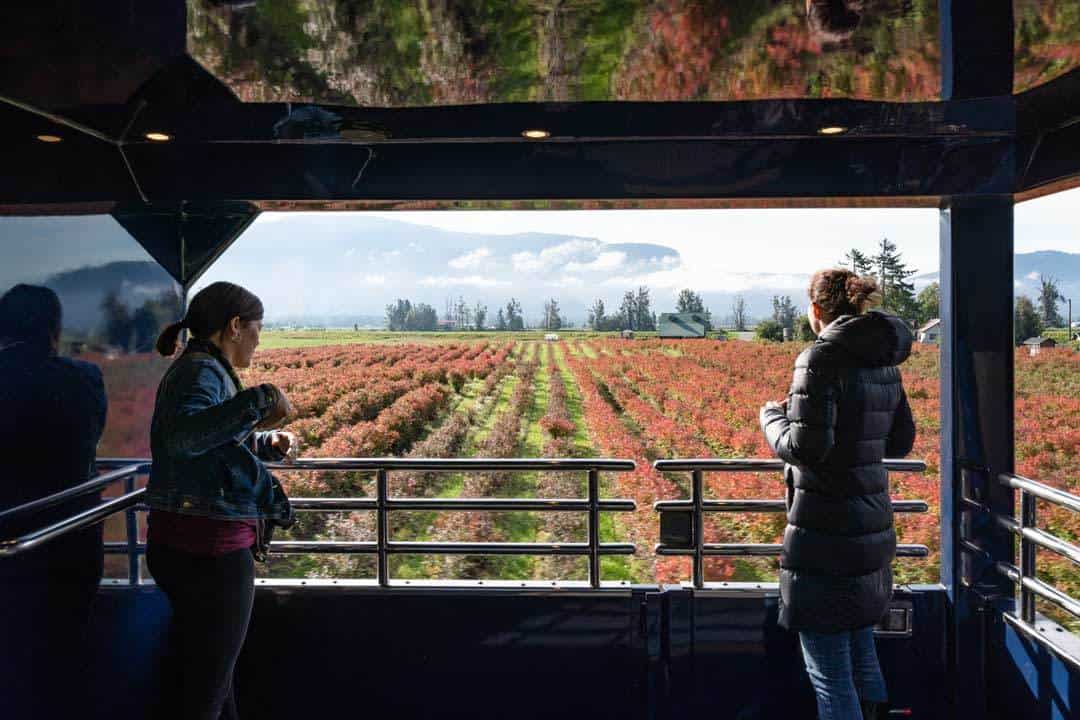
While the train journey itself is what people flock to Western Canada for, the unsung heroes are the Rocky Mountaineer hosts, who are some of the best service people in the industry.
These men and women will be with you every step of the way, making sure your every whim and desire is taken care of.
Need help booking a tour when you get to Banff? They’ll take care of it. Want a shot of Bailey’s in your coffee? Not a problem. Keen for a caesar? Make it two.
Their attention to detail is remarkable, and they are trained to be aware of every person’s needs without being overbearing.
What we liked most about the Rocky Mountaineer hosts though is that each one had character. They weren’t forced to be like stale butlers but rather encouraged to laugh and joke with the guests, and let their true personalities shine through.
When you book a Rocky Mountaineer train journey you can be guaranteed that once you step on the coach you’ll be well looked after every mile that passes by.
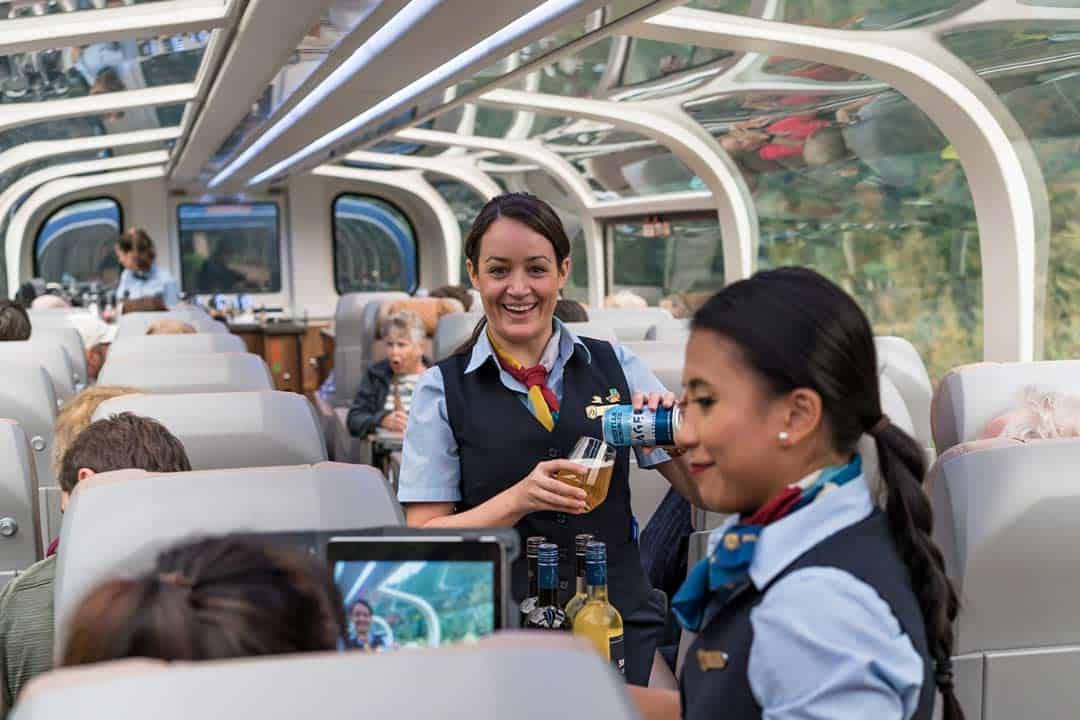
There’s no way we could write a Rocky Mountaineer review without talking about the food.
The meals have such an incredible reputation around the world as being the best on the rails that people actually list it as one of the main reasons to travel with Rocky Mountaineer.
Breakfast and lunch are included each day on the train, and if you’re in GoldLeaf Service you’ll be treated with gourmet delicacies at each mealtime.
The day starts with a high-end breakfast selection. If you’re feeling hungry, go for the complete cook-up, with eggs, sausages and fried vegetables.
Rather something light? The fresh granola and fruit is a perfect option. All of this is of course downed with delicious juice and real coffee.
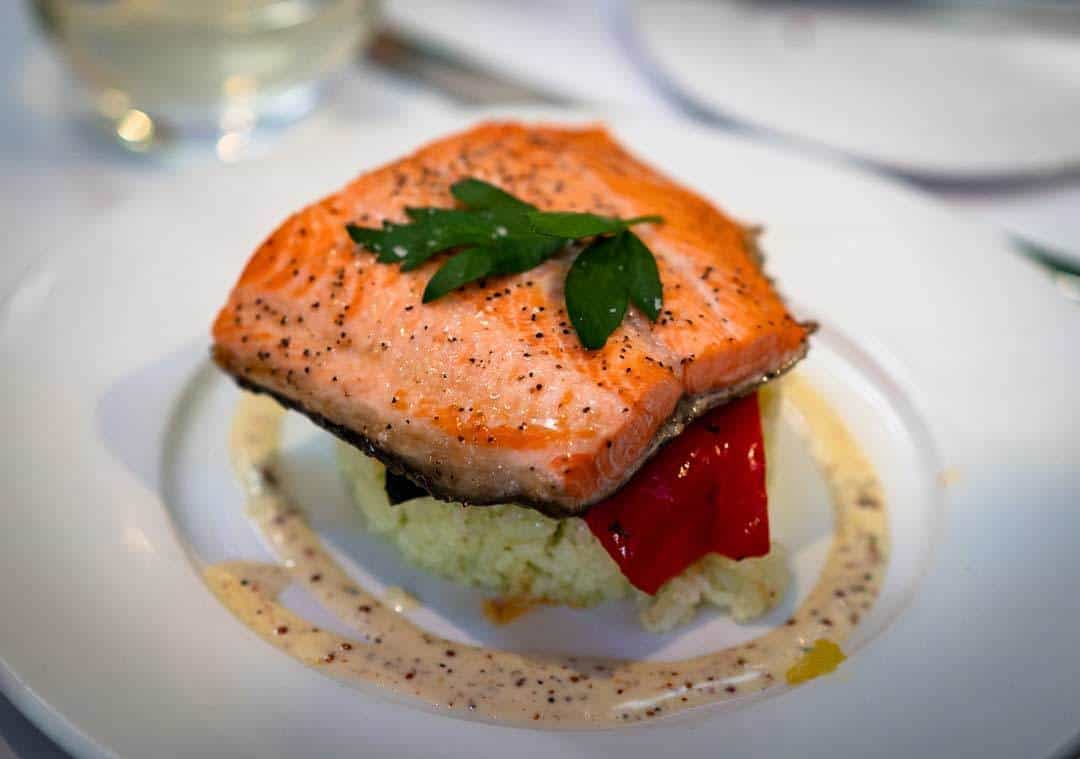
It’s the lunches though where Rocky Mountaineer’s award-winning chefs really are in their element.
They enthusiastically serve up a variety of enchanting dishes using only the freshest local ingredients, with a distinctly Canadian flair over 3 courses.
Whether you’re interested in merlot-braised beef rips, seared salmon from the Pacific Northwest or garlic roasted vegetables, you’re bound to be intrigued by each dish on the menu.
It changes each day, so our tip is that if you see something on the first day that stands out, order it, because it probably won’t be on the menu again.
All of these meals are of course accompanied by the best BC wines, craft beer, juices and coffee available.
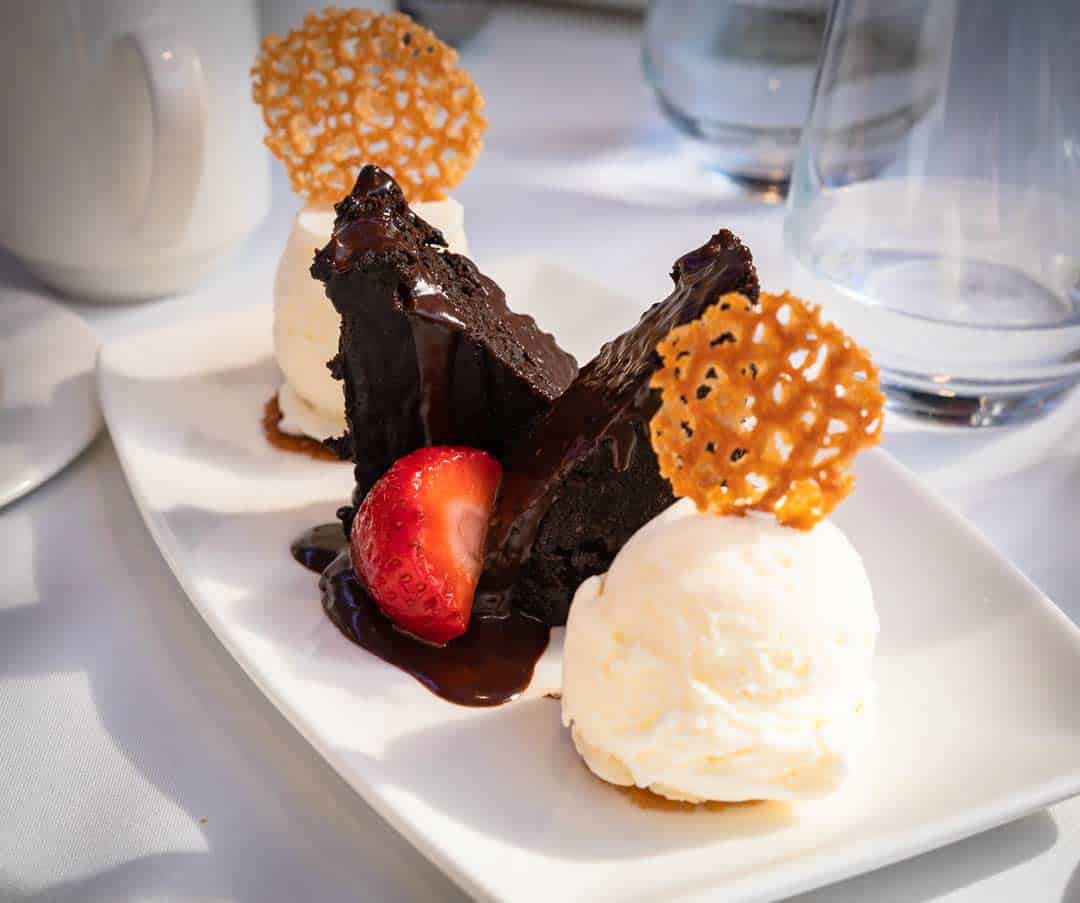
As you don’t sleep on the train, you have the option of staying in a wide variety of amazing hotels in any of the departure, arrival and stopover points along the way.
If you allow Rocky Mountaineer or your travel agent to make the bookings for you, they will find you suitable accommodation depending on your budget.
The benefit of letting them choose your accommodation, or by staying in one of their partner properties, is that they will also organise all transfers for you.
To give you an idea of where we stayed while travelling on a GoldLeaf Service Package, we were in high quality, luxury accommodation the entire way.
In Vancouver we were housed in the iconic Fairmont Hotel Vancouver, in Kamloops we were at the Four Points by Sheraton, and in Banff, we were at the Moose Hotel and Suites.
Rocky Mountaineer’s packages are very easy to book directly through the website , and you can customise each level and upgrades you’d like right there on the booking platform.
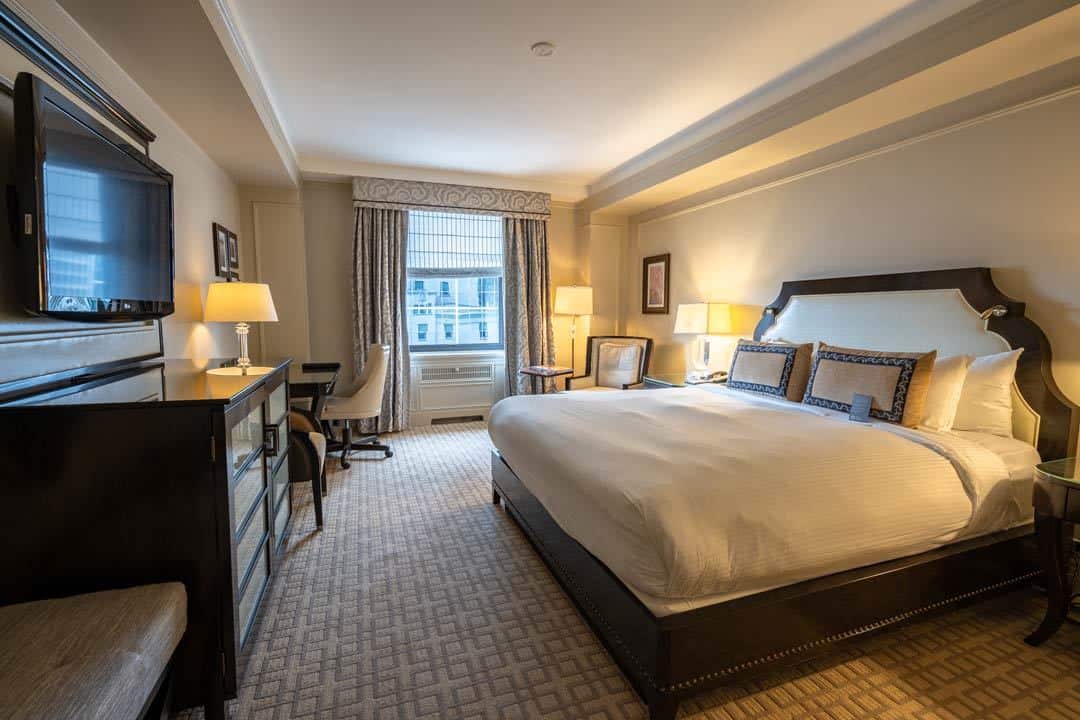
Another cool advantage of booking one of Rocky Mountaineer’s packages is that you can add a number of off-train excursions both before and after your train journey.
If you only have a limited amount of time in each city then this is an excellent way to make the most of your trip without the stress of having to organise your own activities.
Rocky Mountaineer can help you organise a range of luxury, wildlife, soft adventure or sightseeing excursions, depending on your style.
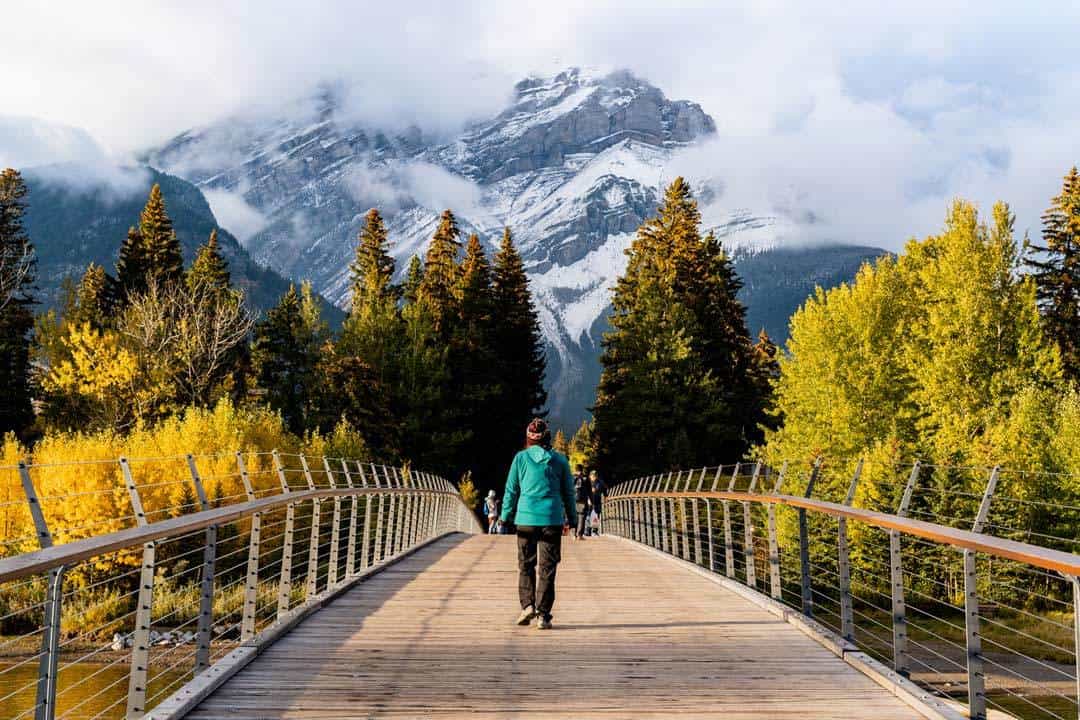
The last thing you want to worry about when you are on holiday is how you are going to get from A to B. Luckily when you book a Rocky Mountaineer train journey you don’t have to.
All transfers between your hotel and the train are taken care of by Rocky Mountaineer’s fleet of luxury coach partners;
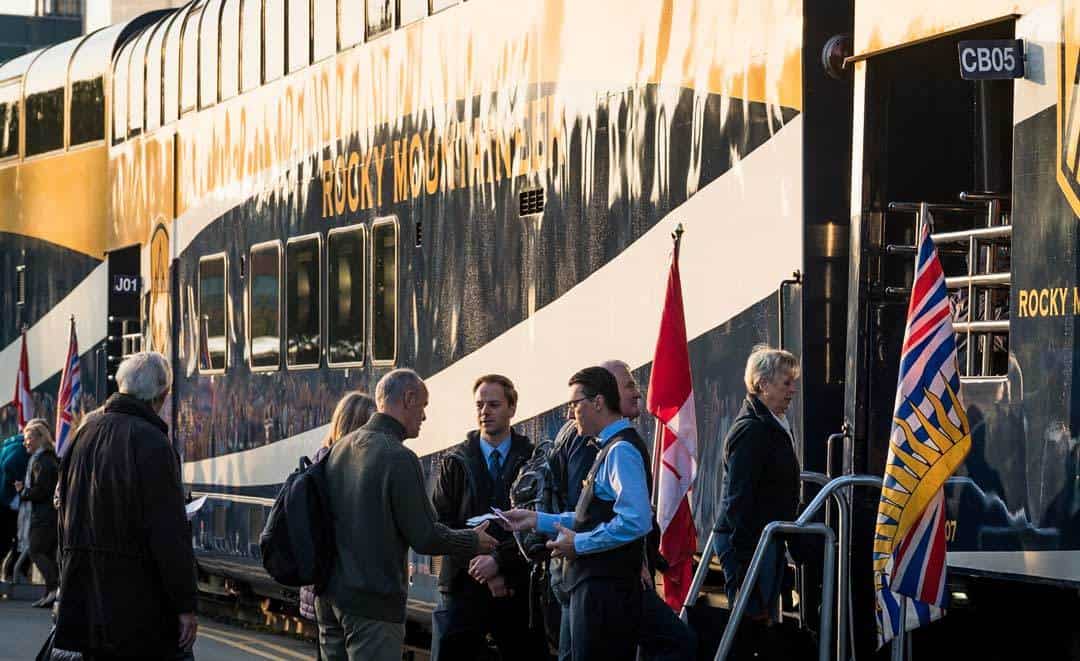
Ease of Service
One thing that we really commended Rocky Mountaineer for is their commitment to making sure every guest’s experience is seamless and enjoyable.
For example, in Vancouver, we had a pre-check-in the day before our journey in the lobby of our hotel, where we could collect our boarding passes and train information ahead of time.
This meant on the morning of departure we just had to catch the bus to the station and then mingle with the other guests with a coffee in hand, already knowing what coach and seat we were in.
Before we arrived in Kamloops the hosts walked through the carriage and actually handed out our hotel room keys.
Rocky Mountaineer had already organised the hotel check-ins, so rather than suddenly having 200 people showing up at the front reception we could just walk straight in and head to our room.
The same service was provided in Banff, and at the end of a long journey, this kind of assistance was much appreciated by everybody on board.
In the lead up to our trip there was a member of Rocky Mountaineer’s customer service team on hand at all times to help answer any questions we had via email, or through the chat system on the website.
All of these little things really did mean that the only thing we had to worry about once we got on the train was whether we wanted a red or white wine with lunch…
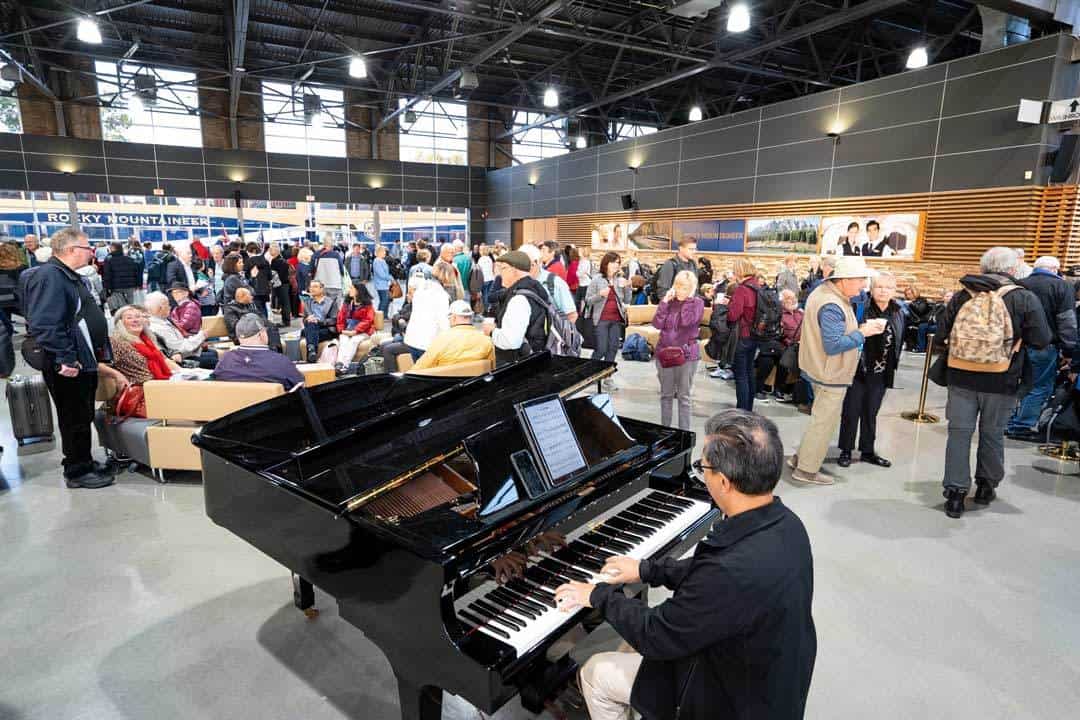
That concludes our Rocky Mountaineer review. We’ve had the pleasure of taking a number of luxury train journeys around the world, and we can honestly say this one was one of the most premium experiences of our lives.
If you found this review useful, or have any questions, please leave a comment below and we’ll answer them as soon as possible.
Our journey onboard the First Passage to the West was made possible thanks to our partnership with Rocky Mountaineer. All thoughts, opinions, and rounds of delicious Baileys and coffee consumed are, as always, our own.
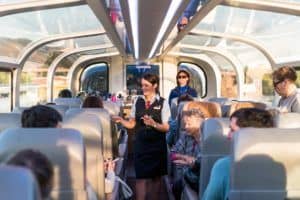
Thinking about experiencing one of the world's best train journeys? Have a read of our Rocky Mountaineer review to get an idea of what to expect along the way!
- Incredible service
- Beautiful views
- Impeccable food
- Bucket list experience
- GoldLeaf glass ceiling is superb
- No sleeping cabins on the train
- Can be expensive
Alesha and Jarryd
Hi, We’re Alesha and Jarryd!

We’ve been traveling the world together since 2008, searching for the planet’s best destinations and adventures.
Love Travel?
Sign up for our free weekly newsletter for the best travel tips, ideas and deals!
We respect your privacy. Unsubscribe at any time.
READ MORE...
Getting Around Magnetic Island – ‘How to’ Transportation Guide
The Ultimate GUIDE to the Best MAGNETIC ISLAND BEACHES and Bays
14 Best Day Trips From Reykjavik, Iceland (2024 Guide)
Related Posts
The ultimate guide to the boz uchuk trek in jyrgalan, hitchhiking canada for a haida killer whale tattoo, the best adventurous things to do in puerto natales, chile (2024 guide), sony zv-1f review – the best entry-level vlogging camera, 16 thoughts on “rocky mountaineer review – everything you need to know”.
What meals are included with the gold package
Hi Joseph, there are many different meals. All of them were high quality and absolutely delicious. It is best to contact Rocky Mountaineer about this and for any dietary enquires you may have. Thank you.
We just realized you only ride train for two days snd the rest is by bus?
The trip from Vancouver to Banff is 2 days on the train. The train stops at Kelowna the first night and you stay in a hotel. he next night you will stop in Banff and stay the night in a hotel in Banff. From Banff to Calgary is about 1.5 hours on the bus. Hope this helps.
When taking this trip as you’ve described, how does one get from Banff to the airport in Calgary. Is it included in the price and does Rocky Mountaineer arrange this?
Hi Alesha and Jarred –
Wonderfully written and descriptive article on Rocky Mountaineer! Sounds like you had a fantastic experience! We and our friends wanted to book a trip for Sept. 2022, but I found many recent Trip Advisor reviews where, due to the pandemic, RM has been holding onto thousands of dollars of deposits even though the trip had been cancelled. We live in California and don’t really know what the current situation is although I have also e-mailed RM to get an explanation and some assurance before we pay the 20% deposit. Sept. 2022 is some time off, but in order to reserve a seat and also get the promotional offers, we have to reserve in a couple of weeks and pay the 20% deposit which will translate to at least $2500 for our group of four. Can you provide any helpful information or contacts where we can get viable information? Thanks very much!
Your review is appreciated. I just wondered how it would feel sitting an entire day for two or three days and how the body responded?
Hi Lalu, you are free to walk around the train at anytime. They let you know when meal times are and there is an outdoor platform. You definitely do not have to sit the whole time. Hope this answers your question.
Hi, thank you for the great review. We plan to undertake this trip this August using Gold Leaf service on the train, but Silver Leaf for the accommodations.
One question: We will travel starting in Vancouver going eastward to Kamloops, etc. Which side of the train would be best to sit, left or right, for the best/easiest views? If there is a preferred side, how do we guarantee assigned seating? We booked this trip through AAA agent.
Hi Esther, sorry we missed your message. I don’t know if you went or not already since this whole health crisis in the world right now, but to answer your question – Either side. The train wides past lakes and through mountains so the scenery changes quickly and you will have great views on both sides. In the Gold leaf service, you get the viewing platform out the back so if a highlight is coming up and it is not on your side you can move to the platform and see it. Hope you had a great trip or have a great trip if it has been postponed. All the best
Thank you for this blog, planning to take this trip next year for my 65 birthday. Gold Level, I agree is the way too experience this amazing adventure.
First passage to the West is my choice, do you find September being the best time to take this trip?
September was a lovely time. Trees were changing colours. It was a little colder so do bring layers if you decided to go at this time. The other thing is that the weather may be touch and go. If may be clear and the views are lovely but it also maybe foggy with low cloud and you may not see some of the mountain tops. The service on the Rocky Mountaineer is wonderful and top class all year round. Have a great trip and happy 65th birthday for September.
hello thanks for the blog! it looks like the leaves turned colors in your photos. Would you please tell me exactly which dates you were on that trip? Thanks.
Hi Camille, Thank you for your comment. We went at a beautiful time of year, at the end of September. The weather is touch and go, so prepare for rain some days and lots of sun on others. The colours changing in the trees was gorgeous and great for photography. 🙂
Sounds wonderful. Please send dates for travel in June 2018. Oh and also please send prices! Thank you.
Hi Barbara, You can book this through Rocky Mountaineer’s website. They have a great team to help, if you have any questions. Happy travels.
https://bit.ly/2PA4mAB
Leave a comment Cancel reply
Save my name, email, and website in this browser for the next time I comment.

The Man in Seat 61
Canada's Rockies by train
The rocky mountaineer.
- Buy train tickets
- Buy ferry tickets
- Book a hotel
- Privacy & cookies
- Home
Train travel UK & Ireland...
Train travel in europe..., train travel in asia..., train travel in africa..., train travel in america..., train travel in australasia, a guide to the rocky mountaineer.
In 1990, Canada's national rail operator VIA Rail sold off it's Rockies by daylight scenic train to a private company called Rocky Mountaineer Vacations, who renamed it The Rocky Mountaineer . It's developed into a world-class travel experience operating on 3 different routes through the spectacular Canadian Rockies, with excellent on-board service. In 1990 the trains carried 10,000 guests, they now carry over 100,000 each year. Rocky Mountaineer offers regular departures April-October and you can buy one-way tickets. This page is an insider's guide to the Rocky Mountaineer .
Routes, dates, times & tickets
What are the trains like?
What's the journey like, other trains in canada, which route to choose.
Rocky Mountaineer runs on 3 different routes. Independent travellers can buy one-way or return tickets between Vancouver and either Banff or Jasper. You can go eastbound or westbound as each route runs in both directions. There's no real 'better' direction, as all the trains are designed to do all scenic sections in daylight.
Vancouver - Kamloops - Banff
Branded First Passage to the West, this is the route I'd recommend. Formerly called the Kicking Horse route after the mountain pass it takes through the Rockies, this is by far the most historically-significant of the 3 routes as it travels over Canada's first trans-continental line opened in 1885, the famous Canadian Pacific Railway . It's Rocky Mountaineer's original route which they started running in 1990 when the last regular passenger trains on this line were discontinued. Rocky Mountaineer is now the only passenger train over this famous & historic Canadian Pacific line.
It's also arguably the most scenic route to choose, as the Canadian Pacific route between Vancouver & Banff has always been considered more scenic than the later Canadian National route between Vancouver & Jasper, although the two routes share the same tracks between Vancouver & Kamloops. You'll run along the wonderfully-scenic Fraser & Thompson rivers, pass the site of the 1885 Last Spike and the Continental Divide, cross the much-photographed Stoney Creek bridge, and pass the pretty station at Lake Louise, Morant's Curve (where countless Canadian Pacific publicity photos were taken) and Castle Mountain. You're likely to see bald eagles, ospreys, and maybe black bears or even grizzly bears .
The Rocky Mountaineer First Passage to the West route runs 3 times a week in each direction from mid-April to mid-October, the journey takes 2 full days with an overnight hotel stop in Kamloops included in the fare. The train used to run to/from Calgary, but currently only runs to/from Banff.
Vancouver - Kamloops - Jasper
Branded Journey through the Clouds, it was formerly called the Yellowhead route after the mountain pass it takes through the Rockies. This route uses the second and later of Canada's two great trans-continental railways, the Canadian Northern line opened in 1917, nationalised in 1921 as part of Canadian National Railways. Between Vancouver & Kamloops the Journey Through the Clouds & First Passage to the West routes are exactly the same - indeed, the two trains sometimes run coupled together. Also note that this route and the Rainforest to Goldrush route share the few miles of line past Mount Robson and through the Yellowhead Pass into Jasper. So if you want to make a circular tour, the best combination avoiding duplication is probably the First Passage to the West route Vancouver-Banff, then by bus between Jasper & Banff calling at the Columbia Icefields, then the Rainforest to Goldrush route between Jasper & Vancouver (you can go in either direction).
The Rocky Mountaineer Journey Through the Clouds route runs twice a week from mid-April to mid-October, the journey takes 2 full days with an overnight hotel stop in Kamloops included in the fare.
Incidentally, Rocky Mountaineer's Journey through the Clouds train takes exactly the same route as VIA Rail's Toronto-Jasper-Vancouver Canadian which runs several times per week all year round . If you're on a budget, an economy class seat on the Canadian between Vancouver & Jasper starts at around $164 versus over $1,000 on the Rocky Mountaineer , making it a much cheaper way to travel through the Rockies by train between Vancouver & Jasper. However, the Canadian runs day & night (sleeping-cars are available) so it passes half the scenery in daylight, the rest in darkness. The Rocky Mountaineer runs the whole route in daylight with an overnight hotel stop in Kamloops so you don't miss any scenery, and of course on-board food & drink is included.
Vancouver - Whistler - Quesnel - Jasper
Branded Rainforest to Goldrush , formerly the Fraser Discovery route , this journey is all about getting off the beaten track into gold-rush and timber country, rather than taking a famous trans-continental rail line. It takes you along the mighty Fraser River over the Pacific Great Eastern Railway (PGE), started in 1885 and only fully completed in 1952 - no wonder it was nicknamed the Prince George Eventually! The scenery is truly wonderful, especially the Fraser River canyon, and you may see bald eagles, ospreys and black bears or even grizzly bears . It runs roughly once a week from mid-April to mid-October, and the journey takes 3 full days with 2 overnight hotel stops at Whistler & Quesnel included in the fare. Until 2015 this train used to start from Whistler, with passengers using the 5-days-a-week Whistler Mountaineer between North Vancouver & Whistler, but the latter train was sadly discontinued in 2016. On the plus side, the main Rainforest to Goldrush train now runs direct to and from North Vancouver station and you still get half a day at leisure to explore Whistler, a ski resort and sort of Canadian Zermatt.
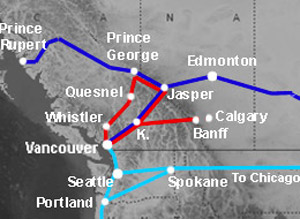
Red = Rocky Mountaineer. Dark Blue = VIA Rail
Light blue = Amtrak . K = Kamloops
Departures, timetable & fares
First passage to the west.
* The day of the week varies, so always check departures with www.rockymountaineer.com for your dates of travel. The train no longer serves Calgary.
Silver Leaf starts at $1,247 inc tax, Gold Leaf starts at $1,705 inc tax.
Journey through the Clouds
* The day of the week varies, so check departures with www.rockymountaineer.com for your dates of travel.
Rainforest to Goldrush
You can check departure dates, times & fares at www.rockymountaineer.com .
Silver Leaf starts at $1,721 inc tax, Gold Leaf starts at $2,337 inc tax.
Back to top
How to buy tickets
Book it with Railbookers : Train travel specialist Railbookers can sometimes get special rates for the Rocky Mountaineer when added to hotels at one or both ends, they can also arrange VIA Rail & Amtrak tickets. In my opinion their package combining VIA Rail's Canadian from Toronto to Jasper with the Rocky Mountaineer from Banff to Vancouver is the ultimate trans-Canada experience.
US call free 1-888-829-4775, www.railbookers.com .
canada call free 1-855-882-2910, www.railbookers.com ., uk call 0207 864 4600, www.railbookers.co.uk ., australia call toll-free 1300 971 526, www.railbookers.com.au ., new zealand call toll-free 0800 000 554 or see website ..
You can also book with Rocky Mountaineer at www.rockymountaineer.com .
Escorted tours
If you'd prefer to see Canada by train on an escorted tour with a convivial group of travellers rather than travelling solo or independently, there are the two UK companies which arrange escorted tours across Canada by VIA Rail's Canadian and the Rocky Mountaineer on various dates through the year. Both companies are part of the same group.
What's the train like?
The Rocky Mountaineer offers two classes of service on each of its routes, Silver Leaf & Gold Leaf .
Which class to choose?
The Man in Seat 61 says, "The Silver Leaf panorama cars are excellent, food & wine is included, and the scenery is exactly the same as you'd see in Gold Leaf. The cost alone may decide for you, and you'll be very happy with your choice if you go Silver Leaf. That said, there are three reasons to consider paying more for Gold Leaf: First, you sit up high in the double-deck Gold Leaf cars, which can give you a better view over trees and so on. Second, the food is more extensive, served in a restaurant rather than at your seat. Third, there's an open air viewing platform, meaning reflection-free photos - for me the incident with the bear proved the value of that viewing platform, nothing between me and a grizzly..." Take a virtual tour inside the Rocky Mountaineer .
Silver Leaf
Silver Leaf service was introduced in 2011, and replaced the cheaper Red Leaf service on all routes from 2016. Silver Leaf passengers travel in a single-deck dome car with huge panoramic windows. The fare includes breakfast and lunch with complimentary beer or wine and non-alcoholic drinks.
This is the premium option. It's not cheap, and the scenery is the same as you'll see in Silver Leaf, but the onboard experience is excellent and more than meets expectations. Is it worth the extra over Silver Leaf? If you can afford it, yes, because of the food, wine, service, and not least, those upper level glass domes give the best all-round view of the Canadian Rockies you can get.
Gold Leaf passengers travel in modern purpose-built double-deck dome cars. Upstairs under the glass roof there are 72 reclining seats with loads of legroom an drop-down tables. Downstairs, reached by spiral staircase or wheelchair lift there are toilets, kitchens, a 36-seat restaurant for breakfast & lunch, and a small open-air viewing platform for fresh air and reflection-free photography.
A pair of attendants in each coach provide live commentary and keep the snacks and complimentary alcoholic & non-alcoholic drinks flowing. Rocky Mountaineer's excellent own-label Sumoc Ridge merlot is very easy to drink - all too easy, really.
Breakfast & lunch are served downstairs in the restaurant in two sittings, included in the fare. There's a choice of excellent main courses freshly prepared in the kitchen and served on real china. Lunch comes complete with Rocky Mountaineer's own-label British Columbian red or white wine.
All passengers get a copy of the 'Rocky Mountaineer newspaper', which features a route guide listing points of interest along the way (referenced by mile post), a map, and information about the train, the history of the route, and the wildlife you might see.
The fare includes a hotel room for the overnight stop, and transfers by motor coach to and from the hotel.
Virtual tour
This excellent virtual tour by Willy Kaemena shows the train in its latest form, with its latest blue and gold colour scheme.
Boarding in Vancouver
If you travel from Vancouver towards Kamloops, Jasper or Banff, see location map of the Rocky Mountaineer Vancouver station . It is located in a former goods yard a little way behind the main Vancouver Pacific Central station used by VIA & Amtrak. When you arrive you'll find complimentary tea & coffee available, and a row of check-in desks for Silver and Gold Leaf. Note that the Rainforest to Goldrush route via Qesnel leaves from North Vancouver station .
This section gives you a flavour of what there is to see on each route. The route guide in your Rocky Mountaineer newspaper on board the train lists these and other highlights, quoting the nearest milepost - the mileposts are black numbers on small white signs placed next to the track every mile. The miles reset to zero at every railway divisional point. Approximate times are used here to give you a better idea of the journey.
First Passage to the West : Banff to Vancouver
This is the most historic and arguably most scenic route operated by the Rocky Mountaineer, previously known as the Kicking Horse route. It takes the original Canadian Pacific Railway through the Rockies, opened in 1885, indeed it is now the only passenger train operating over the original Canadian Pacific trans-continental line. You can make the journey in either direction, between Vancouver and Banff, a resort town in the Rockies. It no longer extends to or from the big city of Calgary. This account shows a westbound journey, note that the departure times have changed slightly since I made this trip, with an earlier departure from Banff, and that the train is shown here in its earlier colour scheme, with red leaf cars ahead of the gold leaf domes, rather than (as now) silver leave cars.
08:40 Banff station: Originally known simply as 'siding 29' on the Canadian Pacific Railway, Lord Strathcona named it 'Banff' after his home town in Scotland in 1880. Banff station is just a few minutes walk from the town centre and 30 minutes walk from the best place to stay in Banff, the famous Banff Springs Hotel . The station building dates from 1910, a replacement for the original 1886 log cabin. If you're joining the train here, you check in at the Rocky Mountaineer desk placed just outside the station waiting room, you're given your seat allocation and your luggage is taken from you - it goes by the truck seen in the photo above and will arrive at your overnight hotel in Kamloops before you do. Tea and coffee are available inside the waiting room until the train arrives. The train left around 09:00 (current departure time is a couple of hours earlier, see the timetable above ).
09:30 Castle Mountain (above right): On leaving Banff, the train winds through the pine trees along the Bow River, with snow-capped mountains on either side of the broad valley. Look out for the impressive and imposing Castle Mountain to your right, around milepost 99. It's an appropriate name!
10:10 Morant's Curve: At milepost 113, 3 miles east of Lake Louise, the train snakes through what has become known as 'Morant's Curve', although strangely it isn't mentioned anywhere in the Rocky Mountaineer route guide or on any map. Nicholas Morant was a photographer with the publicity department of the Canadian Pacific Railway, and this was one of his favourite spots for taking PR shots of CPR trains. If you've ever had a 'railway encyclopaedia' or 'boys book of trains', the chances are that it has an illustration of a Canadian passenger or freight train on 'Morant's Curve', and even today, many of Rocky Mountaineer's brochure photos are taken here. The other classic location for PR shots of Canadian trains in the Rockies is the Stoney Creek bridge, which we'll come to later.
10:15 Lake Louise: The Rocky Mountaineer passes the beautiful 'log cabin' style station at Lake Louse, on the left on a track slightly lower than the one that westbound trains now use. Lake Louise station was used for the station scenes in the film 'Dr Zhivago'. The lake itself is up in the mountains, out of sight. The train now crosses and briefly runs alongside Highway 1, the Trans-Canada Highway.
10:25 Continental Divide (above left): A small monument and wooden sign on the left mark the Continental Divide, and the boundary between Alberta & British Columbia. Rainwater falling east of the divide flows to the Atlantic, rainwater falling to the west makes its way to the Pacific. It's the highest point on the trip, 5,332 feet above sea level. Travelling west, you now put your watch back an hour, as BC is an hour behind Alberta.
09:40 (BC time) Spiral Tunnels: The train passes Wapta Lake and enters the first of the two famous 'Spiral Tunnels'. Inside the Upper Spiral Tunnel, the train describes a complete spiral and emerges further down the mountainside, facing the opposite way. The train then crosses the deep wooded valley and plunges into the Lower Spiral Tunnel to descend even further. Long freight trains can even cross over themselves here! There's a cut-away diagram of the spiral tunnels in your route guide, and the commentary from your carriage attendant will explain it, but it's still disorientating. The spiral tunnels were built in 1907, replacing a dangerously steep section of line known as the 'Big Hill', where many CPR trains and staff came to grief.
10:15 Kicking Horse Canyon: The train calls at Field, an important operating centre for the Canadian Pacific Railway, then heads through the Kicking Horse canyon, crossing and re-crossing the Kicking Horse river several times. The river is narrow, fast running, and blue with meltwater sediment. The train follows the Kicking Horse river for 30 scenic miles, with many bridges and tunnels.
11:40 Rocky Mountain Trench: The train now runs through a wide flat valley full of pines - the Rocky Mountain Trench. The Columbia River is on the left.
13:00 Stoney Creek bridge: This is the other classic location for illustrations of trains crossing Canada. It's a beautiful arched steel girder bridge at milepost 76.2, 484 feet long and 325 feet above the creek bed below, built in 1929. It's the latest of three bridges built on this spot. The approach to the bridge is dead straight, so there's little opportunity to see or photograph the bridge, and although the line curves sharply to the left immediately afterwards there are so many trees in the way that it's still difficult to get a clear view of the bridge. A new tunnel (the 9-mile long MacDonald Tunnel) was built in 1988 to increase capacity by by-passing both the Stoney Creek Bridge and the shorter 1916-built Connaught Tunnel, but the Rocky Mountaineer deliberately takes the original route.
15:55 The Last Spike: The train passes Craigellachie, where on 7 November 1885 the last ceremonial rail spike was driven in, completing the Canadian Pacific Railway and linking Montreal to Vancouver by rail. Here there's a monument and small museum by the tracks, on the right hand side.
16:20 Lake Shuswap & Osprey Alley: The train passes Sicamous, 'The houseboat capital of the world' and for some miles runs along the shore of the huge and beautiful Lake Shuswap. It passes 'Osprey alley', a long line of osprey nests in the tops of telegraph poles and trees by the lake. Watch out for bald eagles, too. After Lake Shuswap comes Lake Mara.
18:50. The mountain give way to gentle hills along the South Thompson River. The hills are volcanic, but at their feet lie sandstone mounds or 'hoodoos', which are the moraines left by ancient glaciers. The country is more arid here, rocky and sandy with fewer trees, very different from the morning's scenery.
19:55 Kamloops: The train pulls into Kamloops for its overnight stop. Motor coaches meet the train and transfer passengers to their hotels. There is a choice of two evening entertainment shows (with food) whilst in Kamloops, both bookable through Rocky Mountaineer, but don't overestimate how sprightly you'll feel on arrival at your hotel at 8pm after a day travelling with so much to take in. Banff to Kamloops is 309 miles.
----- day 2 -----
07:20 Kamloops: Motor coaches pick you up from the hotel and transfer passengers to the station. You may find a longer train than the one you left last night, as the Journey through the Clouds train from Jasper is usually coupled up to the First Passage to the West train between Kamloops & Vancouver. This is the main Kamloops station, VIA Rail's Toronto-Kamloops-Vancouver Canadian uses the smaller Kamloops North. 263 miles to Vancouver, says the station sign.
07:55 The Rocky Mountaineer leaves Kamloops, combined with the Jasper-Vancouver train. It veers right and crosses the Thompson River onto Indian ('first nation') territory, passing a small wooden church on the left that was allegedly used in the film 'Unforgiven' with Clint Eastwood.
Canadian National or Canadian Pacific? Between Kamloops & Vancouver, the 1885 Canadian Pacific (CP) and the later 1917 Canadian National (CN) trans-continental routes run parallel, usually on opposite sides of the river. For the first 58 miles west of Kamloops, the Rocky Mountaineer uses CN tracks in both directions, but between Basque and Vancouver there is 'directional running' where CN & CP co-operate, sending all westbound trains including the westbound Rocky Mountaineer down CN tracks on one side of the river, and all eastbound trains including the eastbound Rocky Mountaineer down the CP tracks on the other side. You see the same scenery, of course, from a slightly different angle, but if you really want to travel on the original 1885 CP tracks (almost) all the way between Vancouver and Banff, you'll need to take an eastbound Rocky Mountaineer.
08:40 Kamloops Lake: The train runs along the shore of Kamloops Lake - watch out for more bald eagles, and for the coloured rocks at 'Painted Bluff' on the right.
09:25 The train reaches the end of the lake and runs alongside the Thompson River. The countryside here is even more arid than before - indeed, it passes Ashcroft, the driest town in Canada.
10:35 Black Canyon: The train passes 'Black Canyon', a section of black lava cliff on the right, with the Thompson river on the left. After Black Canyon Tunnel, the Rocky Mountaineer crosses the Thompson on a steel girder bridge.
11:30 The scenery now changes again, from dry & sandy back to rocky with pine trees. The train enters the Thompson River canyon, with CP tracks one side of the river, CN tracks on the other side.
11:55 Avalanche alley (above right) : The Rocky Mountaineer travels at the very edge of the river under a sheer cliff wall with avalanche protection sheds in several places. One section of the rock wall is attractively coloured, known as 'rainbow canyon'.
12:05 Confluence of Thompson & Fraser Rivers: Just after Lytton the train curves to the left over a bridge across the Fraser River. The confluence of Thompson & Fraser rivers is now on the right.
12:15 Cisco crossing: At Cisco, CP and CN tracks swap sides of the river. The CN line crosses first on an distinctive orange-painted girder bridge (above right), the CP tracks then crossing in the opposite direction on a squared-off black steel bridge lower down (above left, lower picture). Being the first, the CP engineers built their line down whichever was the easier side of the canyon, the later CN engineers had to made do with the opposite, trickier side.
13:35 Hell's Gate: This is the narrowest and fastest-flowing point of the Fraser River. On the right on the far bank is the Hell's Gate cafe, with a suspension footbridge across the river below the train and a cable car over the river and up the mountain.
15:15: We're no longer right next to the Fraser River, which has become very broad. The train is in a wide flat valley, with farms and greenhouses starting to appear. The historic site of Fort Langley is just visible through the trees on the left.
16:50 Approaching Vancouver: The train slows through the freight cars in Thornton Yard, finally curving right over a very long, low steel bridge across the Fraser River with a much higher arched road bridge on the left, which also carries the Vancouver 'Skytrain' metro. Once across the river the Rocky Mountaineer curves sharply right again, weaving its way through the Vancouver suburbs.
17:40 Arrival at Vancouver: We've travelled 594 miles from Banff. Pictured above, the Rocky Mountaineer rolls past the Rocky Mountaineer terminal (on the right, with the buses parked outside). It then slowly reverses back into it. The Rocky Mountaineer terminal is a block away from the Pacific Central station where VIA Rail's Canadian arrives. Rocky Mountaineer's impressive and spacious terminal building was once a diesel locomotive maintenance shed.
Journey through the Clouds : Jasper to Vancouver via Kamloops
This train travels over the second trans-continental line built across Canada, the Canadian National route between Jasper (in Jasper National Park) and Vancouver, opened in 1917. Originally known as the Yellowhead route , it's been marketed as the Journey through the Clouds since 2010.
The Rocky Mountaineer leaves Jasper station around 8am, and heads up through the Yellowhead Pass. This is the easiest pass through the Rockies (in other words the lowest, at 3,718 feet above sea level). The Canadian Pacific chose a more difficult route through the Kicking Horse pass to the south because of political tensions between Canada and the USA at the time, and a desire to safeguard Canadian territory.
Look out for the highlight of the trip, views of snow-capped Mount Robson to the right of the train. At 12,972 feet it's the highest mountain in the Rockies.
After running alongside Moose Lake, the train crosses the Fraser River.
For almost 20 miles, the train passes some of Canada's most magnificent mountains in the Premier range, named after early Canadian prime ministers.
The train passes the site marked by a small cairn, where 12 members of the Royal Canadian Horse Artillery were killed when two CN trains collided.
The train passes Pyramid Falls (see photo above), where water cascades 300 feet beside the tracks.
The train arrives at Kamloops and passengers stay overnight in a hotel, included in the fare.
Between Jasper & Kamloops the Journey through the Clouds takes exactly the same route as VIA Rail's Canadian , which also (if it's on time, of course...) does this section in daylight, before continuing through the night to Vancouver. So see the Jasper-Kamloops photos on the Toronto-Vancouver Canadian page .
On day 2 the Journey through the Clouds travels from Kamloops to Vancouver coupled to the First Passage West , see the Kamloops-Vancouver photos above .
Rainforest to Goldrush: North Vancouver - Whistler -Quesnel - Jasper
This is a less well-known but remarkable route, through the gold rush & timber country of the Cariboo. Until 2010 this route was marketed as the Fraser Discovery route and until 2015 it started at Whistler and you had to take Rocky Mountaineer's Sea to Sky Climb train between North Vancouver & Whistler, which was also useful for local journeys as it ran 5 times a week and could be used by people just going to Whistler. Unfortunately, Rocky Mountaineer have discontinued their Vancouver-Whistler train, instead from 2016 the main Rainforest to Goldrush train will start from North Vancouver.
06:15 - 07:15: Passengers are collected by motor coach from central Vancouver hotels, and driven through Stanley Park and across the Lion's Gate Bridge to the North Vancouver station, a simple siding a block or two away from the original BC Rail passenger station. BC Rail stopped normal passenger service on his route in 1999.
07:30 Leaving Vancouver: After leaving North Vancouver, the train passes right under the Lion's Gate Bridge and over a girder bridge across the Capilano River (Vancouver's famous Capilano footbridge, www.capbridge.com , is out of sight further up the valley). Breakfast is served.
The train runs alongside the sea (on left hand side) until it heads off into the mountains. It passes through the mile-long Horseshoe Bay Tunnel, built to eliminate a difficult section of line around the headland, emerging onto the banks of Howe Sound. For some miles the train run along the banks of this beautiful sound (also on left hand side) past the BC Ferries terminal serving the islands. The trains passes waterfalls and an old copper mine, once the largest copper mine in the British Empire and now a museum.
09:50 Cheakamus Canyon: The train starts to climb, away from Howe Sound up into the hills. This is the most scenic part of the journey, as the train passes over several high trestle bridges along the Cheakamus canyon (pictured, above) with the narrow fast-flowing river way down below.
The train passes over the top of 195-feet-high Brandywine Falls.
11:30 Whistler: The train arrives at Whistler station. This is in the Creekside area of Whistler, near Nita Lake. A fleet of buses meets the train and transfers passengers to their hotels in Whistler Village a mile or two away. You now have the afternoon and evening free to explore Whistler, and you stay there in a hotel overnight. Whistler is one of Canada's biggest ski resorts, a sort of North American Zermatt. Cable cars run up the mountains, seaplanes run scenic flights, and there are many outdoor activities in both summer and winter. The centre of Whistler village is pedestrianised, with many bars and restaurants.
07:30 Leaving Whistler: The Rocky Mountaineer train leaves Whistler at 07:30 on day 1. Whistler station is in the Creekside area of Whistler between Alta and Nita lakes, a few minutes' taxi or motor coach transfer from Whistler village itself. Check-in opens at 06:30, you hand over your luggage (which travels by road) and you are given a boarding card with seat allocation.
08:10 Green River, Birkenhead River: Breakfast is served as you pass through snow-capped mountains and run alongside the Green River. The scenery is beautiful, although there are still houses and occasional timber yards here, not to mention a few power pylons! The Green River soon gives way to the Birkenhead River, also on the right, but flowing in the opposite direction.
08:35 Nairn Falls: The train crosses a low bridge just above the top of a waterfall in the pine trees, Nairn Falls.
10:00 Anderson Lake: The train skirts the blue waters of Anderson Lake right by the water along the cliffs. The tracks follow the shore for 15 miles, with many photo opportunities.
10:30 Seton Lake: The train passes the end of Anderson Lake and crosses the spit of land known as Seton Portage separating it from another lake, Lake Seton. Originally one big lake, lakes Anderson and Seton were separated by a landslide over 1,000 years ago. Lake Seton is a luminous turquoise colour, an effect caused by the sediment washed down by meltwater from the mountains. The train passes the BC Hydro Bridge River hydro electric plant and a timber yard.
11:20 Lillooet: Lillooet is a major railway town, and there's a 10-minute locomotive crew rest stop here in the freight yards.
11:35 Fraser River Canyon: After leaving Lillooet, the train crosses the wide and brown Fraser River on a massive and dramatic girder bridge, 800 feet long and 190 feet above the river. Immediately after the bridge the train snakes left onto the Fraser's left bank and starts climbing a steep 2.2% gradient for the next 30 miles. It's one of the longest sustained 2.2% rail gradients in America. This 30 mile stretch is the highlight of the trip: The train follows the Fraser River canyon, high up on the mountainside with the river far below. The sheer scale of the canyon is spectacular. There are few trees, the landscape is arid an sandy here.
13:00 Cariboo Plateau: The train finally leaves the Fraser River canyon. It's now on the Cariboo plateau, and pine trees make a welcome reappearance. These are the gentle rolling hills of cattle country.
16:00-17:00: Still on the Cariboo plateau, this is also timber country. You can smell the sawdust from the many lumber yards. You pass Lac La Hache and Williams Lake.
18:00 Deep Creek Bridge: 1,194 feet long, 312 feet high, one of the highest rail bridges in North America (in fact, only the Stoney Creek bridge on the Banff-Vancouver route is higher). You pass many cattle ranches, and can spot many deer in the wooded areas.
20:00 Quesnel: The train passes lumber yards and the occasional osprey nesting in telegraph poles or tall trees, and arrives at Quesnel (pronounced 'kwanell') for the overnight hotel stop. Quesnel is the local centre for the Cariboo, and if you've never seen small-town Canada it's well worth an evening wander. This is easier to do if you're at a town centre hotel such as the Best Western, less easy if you're in a hotel a few miles out (Gold Leaf passengers are currently bussed a few miles out to the Sandman's hotel in an industrial/retail area). Personally, I'd suggest requesting the town-centre Best Western even if you're in Gold Leaf. In Quesnel you'll find the longest wooden truss footbridge in the world across the wide and fast-flowing Fraser River, pictured above right - check out the steak house & pub on the hill the other side! There's also a Greek restaurant, a casino built to look like an old paddle steamer, and a gift shop by the river that's often open in the evenings when the train arrives. There's a town museum (complete with allegedly haunted doll 'Mandy') which you may or may not find open when the train comes in.
----- day 3 -----
07:40 Leaving Quesnel: Motor coaches transfer you from the hotel around 06:45, and the Rocky Mountaineer leaves Quesnel around 07:40 when everyone is on board.
08:00 Cottonwood Bridge: The train crosses the dramatic Cottonwood bridge, 1,023 feet long and 236 feet high, over a valley full of pine trees with a river racing beneath. The bridge was only completed in 1952, the last major link in the railway from Vancouver to Prince George and Prince Rupert. The 'last spike' was driven in 8 miles further on, at the slightly smaller Abhau Creek bridge, on 31 October 1952. Since they started building the line in 1912, it was no wonder the Pacific Great Eastern Railway became known locally as the 'Prince George Eventually'!
09:10: The Fraser River is sighted again, on the left. Endless pines and birch trees, and the odd sawmill including a fully automated one at Dunkly.
10:20 Prince George (almost!): The Rocky Mountaineer makes slow progress through the yards approaching Prince George. The train heads for a long low steel bridge across the Fraser into Prince George, which is the route passengers trains (when there were any) would normally take. But immediately before the bridge the train turns right at a triangular junction onto the line leading out of Prince George towards Jasper. The train is no longer on the Pacific Great Eastern but on the Grand Trunk Pacific. The GTP is Canada's third trans-continental line, built from Jasper through Prince George to the pacific ocean at the port of Prince Rupert. Although not in the same league as Vancouver, much freight is still shipped overseas via Prince Rupert. The GTP was nationalised after its bankruptcy in 1921 and is now part of Canadian National Railways.
12:30: Lunch is served as the train enters the Rocky Mountain trench, a wide valley between the mountains. The train follows the meandering brown river through the pines and birches.
16:00: The train passes McBride, with agriculture now in evidence across the valley.
17:50 Mount Robson: Another highlight of the trip, the train passes Mount Robson, the highest mountain in the Rockies at 12,972 feet. The Rocky Mountaineer Journey through the Clouds route also passes this spot, so gets this same view of Mt Robson, as does VIA Rail's Toronto-Vancouver Canadian .
18:10: The Fraser river is now narrower, cleaner and greener. The valley narrows, with snow-capped mountains on each side.
18:50 Yellowhead Pass: The train joins the Jasper-Kamloops-Vancouver main line, and passes through the Yellowhead Pass. This is the easiest and lowest pass through the Rockies at 3,718 feet above sea level. The train crosses from British Columbia into Alberta, and the clocks go forward an hour.
20:30 (19:30 BC time) Jasper: The train arrives at Jasper, at the heart of Jasper National Park. The station is right at the front of this small town, which grew up around the railway. Jasper station is used by two Rocky Mountaineer routes and VIA Rail's Toronto-Jasper-Vancouver Canadian .
Bear! bear! bear !
You may see ospreys, bald eagles and deer from the train, and if you're lucky maybe a bear or two. There are two sorts of bear, black bears are more common, grizzly bears less so. Keep your eyes peeled! In Jasper, you'll see many elk just wandering about the outskirts of the town. Below, the best bear sighting they've had for several years on the Rainforest to Goldrush route, approaching Jasper near Mt Robson.
G uidebooks

Buy Rough Guide from Amazon.co.uk or Amazon.com
Or buy direct from the Lonely Planet website , with shipping worldwide.
The Trans-Canada Rail Guide
Trailblazer's Trans-Canada Rail Guide is well worth buying if you're planning a trans-Canada train trip. It will help you plan your journey, and best of all it includes mile-by-mile lineside route guides showing what to see from the train on all the main VIA Rail & Rocky Mountaineer services. Buy in the UK from Amazon.co.uk . Buy in the USA from Amazon.com
Recommended hotels
In vancouver: fairmont vancouver hotel.
In the centre of downtown Vancouver, next to Christ Church Cathedral and only a few blocks from the Waterfront, the Fairmont Vancouver Hotel is a former railway hotel. It was started by Canadian National Railways but completed in partnership with rival Canadian Pacific, opened in 1939 by King George VI and Queen Elizabeth. It's another iconic Canadian chateau-style hotel, a true Vancouver landmark. And if your budget will stretch, Fairmont won't disappoint.
If you want something cheaper, try the St Regis Hotel , also excellently located downtown and also a historic Vancouver landmark, opened in 1913.
In Jasper: Fairmont Jasper Lodge
First established in 1915 in association with the Grand Trunk Pacific Railroad, it became a Canadian National Railway hotel in the 1920s. Bing Crosby, Marilyn Monroe, and members of the British Royal family including King George IV and the Queen have stayed here. It's on Lake Beauvert, a 9 minute drive from Jasper station.
In Banff: Fairmont Banff Springs Hotel
Another famous classic hotel, originally built & owned by the Canadian Pacific Railway and designed in the style of a Scottish castle. If your budget will stretch, it's the most celebrated hotel in Banff and an experience in itself.
Flights to Canada
Overland travel around Canada by train & bus is an essential part of the experience, so once there, don't cheat and fly, stay on the ground! But a long-haul flight might be unavoidable to reach Canada in the first place. To compare prices for flights to Montreal, Toronto or Vancouver, check Skyscanner .

Lounge passes
Make the airport experience a little more bearable with a VIP lounge pass, it's not as expensive as you think! See www.loungepass.com .
Back to home page
I took a 2-day luxury train across the US southwest that costs $1,500. It was a bucket list trip, but I wouldn't do it again.
- I took the Rocky Mountaineer train from Denver, Colorado, to Moab, Utah.
- The once-in-a-lifetime trip usually costs $1,465. I purchased my ticket on sale for $1,052.
- While I had an incredible time, I won't go on another Rocky Mountaineer train anytime soon.
With a red carpet unrolled, I boarded the Rocky Mountaineer train with a backpack, iced latte, and high expectations.
Last May, I boarded the Rocky Mountaineer train in Denver, Colorado, and headed to Moab, Utah. It would be my first major railway trip in the US and also one of the most expensive trips I've ever booked. My solo ticket for the two-day journey retails for $1,465, although I bought my ticket on sale for $1,052.
The Rocky Mountaineer is heralded as one of the most luxurious trains in the world . The railway company operates three routes out of Western Canada, and last year, it launched its first US route between Moab and Denver.
As I booked the two-day trip, I was enticed by glass-dome windows, quality meals, and endless spirits. I admired the company's commitment to appreciating the landscapes the train passed: There'd be a train host in each car who would explain the region's history. Plus, the Rocky Mountaineer advertises itself as a "daylight-only train," so I'd have an overnight stop at a hotel in Glenwood Springs, Colorado, included in the train ticket.
Overall, the promises of luxury held up, but as I disembarked the train, I couldn't justify the cost. For me, the Rocky Mountaineer will likely just be a once-in-a-lifetime trip.
My Rocky Mountaineer train ride was an unforgettable trip. I met new people, heard captivating stories, and saw grand landscapes.
There were plenty of highs on my two-day trip, but as the train arrived in Moab, I was unsure if I'd book another one of the train's routes. While the scenery was awe-inspiring and the customer service was top-tier, I don't think I could justify the price.
Plenty of elements of the two-day journey were filled with luxury.
During the entire two days, I noticed thoughtful details that created an effortless trip.
Mimosas were waiting for passengers once they boarded the train, my luggage was delivered and waiting for me in my hotel room at the end of the day, and the panoramic windows sparkled without a single smudge.
The entire train staff provided personalized storytelling and some of the best customer service I've experienced while traveling.
But I wish I had more time to appreciate and experience the scenery, instead of quickly passing by.
As we crossed the Colorado-Utah state line, our train host, who served as a tour guide for most of the trip, excitedly told us to whip out of phones and get ready for a photo opp.
In just a few moments, our train host said we would pass a set of stairs carved into the rusty red La Sal Mountains, which were created by the Ute people hundreds of years ago.
I saw the stairs for a split second, and everyone eagerly checked to see whether or not their picture turned out blurry. As the train flew by, I couldn't help but feel a bit disappointed: I would have liked to admired the stairs for more than a few moments.
That feeling felt like a theme of my train ride as we passed historic tunnels, mesmerizing views, and powerful rivers. To me, it felt like I was seeing the outdoors instead of experiencing it. As I sat in a pleather seat sipping prosecco, I realized that I would rather be hiking, sweaty, and snacking on trail mix instead.
I learned too late that I might not be the target traveler for the Rocky Mountaineer. I'm at a point in my life where adventuring into the wilderness is where I find joy. I'd rather be in nature than view it from a glass-dome window.
I realized that my money could take me farther on other trains and trips.
Not only am I at a time in my life where exploring wilderness makes me happy, I'm also at a point when $1,000 is a lot of money. Spending more than $1,000 on a two-day train trip, which doesn't include accommodations back to your departing city, wouldn't be possible if I wasn't reporting on the ride for work .
The rest of my five days in Utah cost a little over $2,100, which included food, accommodations, national park entrance fees, activities, gas, and a car rental.
During those five days outside of the train, I thought my dollar stretched further without sacrificing the quality of my meals or accommodations. I drove 700 miles around the state and explored more than a dozen of pit stops . I stayed in welcoming chateaus in Utah's Little Switzerland and ate meals at famed Moab breakfast joints .
If I decide to book another train trip out West, I'd consider Amtrak. According to Amtrak's website , a similar journey from Denver to Green River, Utah, which is about an hour north of Moab, costs passengers $50 for a coach seat and about $418 for a private roomette cabin this upcoming May.
I imagine that an Amtrak experience would feel less like a vacation and more like a commute, but I'm not sure the Rocky Mountaineer's amenities, while far luxer than Amtrak, were worth the significant price difference, in my opinion.
I also thought a few elements of the trip came up short.
While the Rocky Mountaineer was a luxe trip, I found that a few aspects didn't meet my expectations.
The train company advertises an outdoor viewing platform. Leading up to the trip, I envisioned myself enjoying it with the wind in my hair while sparking conversation with other travelers, and enjoying the sunshine in the open-air space.
But when I boarded the train and searched for the platform, I was disappointed. The outdoor space was a small area between train cars with only enough room for two people, and the views were more limited than the ones from the train cars with glass-dome windows.
"Space on the train is very limited and our coaches are meticulously designed to make the best use of the space," a spokesperson for Rocky Mountaineer said in an email. "Our guests tell us they appreciate the outdoor viewing area as it offers the opportunity to get some fresh air, capture photos, and take in the scenery from a different vantage point."
My expectations were also not met when it came to my vegetarian meals. When I booked the trip, I had the choice between Asian vegetarian meals, diabetic meals, gluten-free meals, low-fat meals, non-lactose meals, vegan meals, and vegetarian lacto-ovo meals. With so many options, I assumed I'd enjoy a hearty vegetarian meal.
Unfortunately, I thought the reality was a bit lackluster. For lunch on the first day, a vegetarian meal wasn't listed, so I was served a larger version of the salad that everyone ate as an appetizer. The next day, I appreciated that my train chef whipped up a dish for me, but I hoped for a bit more than was served.
"Our onboard team does its best to accommodate dietary preferences wherever possible. Space in the train's galley is limited, so when we know in advance, there is an opportunity to work with our culinary team to bring additional meal options onboard," the spokesperson said. "On the route you traveled, there are typically two selections on the menu. The vegetarian meals are sourced and prepared in addition to the standard menu and may vary, based on the freshest options the culinary team can provide."
I likely won't board the Rocky Mountaineer again anytime soon, but that doesn't mean it wasn't an epic journey.
While I disembarked the Rocky Mountaineer unsure I'd book another trip, the train ride reignited my appreciation for America's west and left me with unforgettable memories. And other Rocky Mountaineer travelers agree.
After publishing stories about my trip, dozens of readers reached out to share their memorable reviews. They wrote about the breathtaking views, friendly staff, and life-changing experiences aboard the trains.
Their stories are echoed in the reviews on TripAdvisor and the comments section of the Rocky Mountaineer's Facebook page . The consensus was, it's a highly memorable way to travel.
And perhaps if I reach a time in my life where $1,500 is easy to spend on a two-day trip or the appeal of hiking wears off, I'll reconsider boarding the Rocky Mountaineer. But for now, I'm thankful for my experience and ready to discover other ways to explore the US.
- Main content
Emergency Banner Component
Denver to Salt Lake City by Rocky Mountaineer
Select Year
Select Group Size
- Small Group
Select the direction you would like to travel.
- 2024 Eastbound
- 2024 Westbound
- 2025 Eastbound
- 2025 Westbound
Accommodations
- Pricing & Availability
- Important Info
Uniquely Tauck
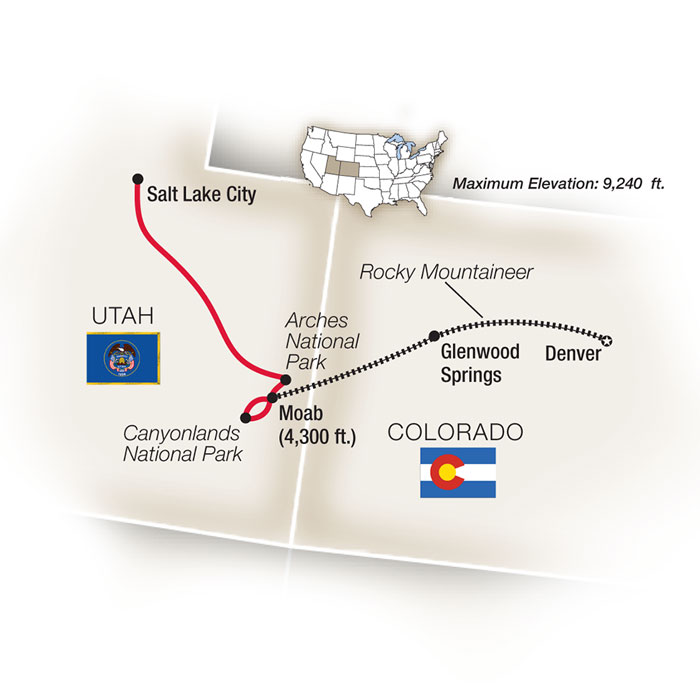
EXPERIENCE WITH TAUCK
Take a two-day train journey amidst the wilderness splendors aboard Rocky Mountaineer, combining best-in-class Silver Leaf Plus rail service with unrivaled scenic vistas from Moab, Utah to Denver, Colorado and an overnight hotel stay in the historic mountain town of Glenwood Springs
Flightseeing over the geologic wonders of Canyonlands National Park provides a memorable bird's-eye view
TAUCK VALUE INCLUDES
Enjoy a choice of outdoor adventures in Moab, including a jet ski excursion on the Colorado River or a ride aboard a 4x4 Hummer that takes you off roading into red-rock terrain
Embark on a guided driving excursion in Arches National Park amidst sculpted sandstone scenery in one of the Southwest's most gorgeous national parks
Drive through the foothills of the Colorado Rockies during a two-night stay at the Four Seasons hotel in the heart of Denver
SEE WHAT YOUR JOURNEY INCLUDES
Guests should be able to easily walk one to two miles, which may include climbing one or two flights of stairs and walking over uneven pavement, groomed hiking trails or cobblestones. Standing up to one hour or more may be required.
Moderately paced, and may include some early morning hotel departures, one or two on-tour flights, and extended motor coach travel.
Legendary Journeys and Adventures
Enjoy front row views of nature's perfect playgrounds, from aboard a luxury train and a flightseeing plane, and a jet boat or a 4 x 4 Hummer, along with short hikes and drives that showcase wilderness wonders, on a new journey that is awe-inspiring everywhere you look
The majestic parks of moab.
A serene desert oasis that doubles as the gateway to Arches and Canyonlands national parks, it's no surprise that Moab, Utah, surrounded by breathtaking red rock landscapes, scenic rivers and forests, is renowned for its dramatic scenery. Just five miles to the north, in Arches National Park, you'll find the world's largest concentration of sandstone arches, some 2,000 of them all in one place. You'll also discover giant balancing rocks, soaring pinnacles and larger-than-life spires as you explore the park with us. Nearby, the largest national park in Utah, Canyonlands, staggers the imagination with a diversity of naturally sculpted sights. A flightseeing excursion over the park provides you with an unforgettable bird's-eye-look and spectacular views of this vast geologic wonderland.
Best in class service aboard Rocky Mountaineer
Venture into the Rocky Mountains as never before on a two-day journey memorable in every way. Experience best-in-class Silver Leaf Plus service aboard the luxury train Rocky Mountaineer, where gourmet dining, premium beverages and personalized service from storytelling hosts cater to your comfort in style. Indulge in panoramic daytime views of the enchanting landscapes between Moab, Utah, and Denver, Colorado, from custom-designed glass-dome coaches and exclusive access to a VIP lounge where you can feast on scenic splendors everywhere you look. An overnight stay in the historic hot springs town of Glenwood Springs promise restful accommodations before your second day immersing in the extraordinary beauty of the Rockies.
Tunnel under the Continental Divide
In Colorado, the Continental Divide runs along the crest of its majestic Rocky Mountains, separating western regions of North America from those to the east and delineating how precipitation flows onto land. While you can cross the divide on mountainous trail roads, you'll go under the peaks through the historic 6.2 mile Moffat Tunnel in north-central Colorado. The tunnel, sitting at an elevation of 9,200 feet, was first conceived by railroad entrepreneur David Moffat as a rail link between Denver and Salt Lake City. He died before it was completed in 1928, but his vision enables trains like the Rocky Mountaineer to safely cross the mountains with ease and comfort.
The Rocky Mountains
One of the most beautiful, as well as the largest, mountain range in North America, the Rocky Mountains stretch more than 3,000 miles from British Columbia to New Mexico, forming the "backbone" of North America, known as the Continental Divide. In Colorado, its landscapes are wild and wondrous, abundant with animals and birds that make their homes in the forested slopes, vast canyons, river banks and craggy peaks you'll view here. And while visitors have the opportunity to see them up close on road trips and hikes in certain places, as a guest aboard the Rocky Mountaineer, you'll immerse in spectacular wilderness vistas only accessible by rail, enjoying picture perfect moments in pristine panoramas you'll have all to yourself.
Download, Print Or Share
Take The Details With You
Download day-by-day details.
All the information you need for this journey at your fingertips – day-by-day details, map, hotel descriptions, key highlights and more.
Where you stay is an important part of your journey – with Tauck, accommodations have been handpicked and carefully selected for their location and ambiance, enhancing the destinations you explore. Download accommodation details and your travel plans begin!
Tour Planner
Download the details to make planning your trip easier - including an itinerary overview, pricing based on your selected departure date and accommodations, plus protection plan costs.
Request A Tour Planner
Overnight Accommodations
Extend your stay
Arrive Early
Four seasons denver.
Denver, Colorado
Object reference not set to an instance of an object.
Glenwood Springs – TBA
Hoodoo moab, curio collection by hilton, the grand america hotel.
Salt Lake City, Utah
Find your tour
Pricing & Availability
Pricing & Dates are not available yet. Please check back soon.
Eastbound: Salt Lake City → Denver
No departures found.
Try using less filters or select a different year.
Westbound: Denver → Salt Lake City
Want more detailed information.
Request a Tour Planner
Call 800-788-7885
About Booking This Tour
Travel Documents
Salt Lake City to Denver / Denver to Salt Lake City by Rocky Mountaineer begins and ends in the U.S.
Real ID Act - Effective May 7, 2025
Beginning in May 2025, some state IDs will no longer permit you to board a domestic flight. Currently, some states are compliant, some have received extensions, and some are not compliant. Click here to see the status of your state. If your state license is not compliant, you can use a passport in lieu of a valid state ID.
Please Note: The federal government has extended the deadline to May 7, 2025 for domestic airline passengers to secure a Real ID driver's license for use as identification at the airport. Travelers without a verified license or ID card will also have the option of showing other identity documents, such as a passport or military ID to board a plane.
If you are a citizen of another country traveling internationally, you should contact an embassy or consulate of the U.S. to determine what travel documentation is necessary. You may also log on to the U.S. State Department's Internet site by clicking here.
If you are traveling by air to join and/or depart from this tour within the U.S ., please read the section entitled Airline Security Measures to determine what travel documentation is required.
If you are a citizen of the U.S. or Canada who travels frequently between the two countries , you may benefit from the NEXUS program, which is a joint initiative between the U.S. Customs and Border Protection Agency and the Canada Border Services Agency that allows pre-screened and approved travelers faster processing at designated highway lanes in high-volume border crossing locations, at a NEXUS kiosk at several airports, and at certain marine reporting locations in the Great Lakes and Seattle regions. For further information, you may log on to the Nexus Internet website by clicking here . Please note that longer stays abroad for any purpose may require additional travel documentation.
We recommend that you make at least two photocopies of all the travel documents that you bring with you. Include copies of the photo page of your passport that contains the date of issuance, the date of expiration and your citizenship. Secure one set of copies in the safe in your room while traveling and leave one set behind with someone at home who will assist you in the event your documents are misplaced, lost or stolen.
To facilitate Travel Requirements, destinations are increasingly utilizing online forms that require digital proof that you've successfully completed your submission (via an email, QR code, etc.) To ensure smooth travels and peace of mind, we strongly recommend all guests carry a personal smart phone and sign up for international data plans before traveling overseas.
Note: For activities marked with an asterisk (*) in day-by-day descriptions, participation is at your own risk; a signed liability waiver will be required.
TRAVELING WITH CHILDREN AS A GUARDIAN: If you are traveling as the guardian of a child/children, we strongly suggest that you carry a letter from both parents of the child authorizing emergency treatment in the event of illness or accident. For travel abroad, many foreign countries have specific entry requirements for children under 21 who are traveling internationally without BOTH parents. (These requirements are in response to the increased incidence of children being abducted and taken abroad.) PLEASE NOTE THAT TAUCK IS NOT RESPONSIBLE for the disruption of travel caused by improper documentation for children traveling without both parents.
How to Book a Tour
See your travel advisor, or call Tauck at 800-468-2825 to make a reservation.
At the time of booking, please have the following information ready for all members of your party:
- Tour Name and Departure Date
- Traveler's Name: First and last names as they appear on your passport or driver's license
- Traveler's Address(es)
- Email Address*
- Traveler's Phone Number(s)*
- Emergency Contact Information: Please provide the name and phone number of a relative or friend (not travelling with you) whom we could contact during the tour in the unlikely event of an emergency
- Interest in purchasing a travel protection plan (US and Canada)
- Interest in extending your trip by staying in a Tauck recommended hotel before your trip begins or after it ends
- Interest in our specially negotiated airfares
* Required Fields
Deposits & Final Payment
The deposit and the fees for the optional Protection Plan or Cancel Fee Waiver [CFW] coverage are due at time of booking.
The deposit amount is $525 per person
Final Payment:
Final Payment is due to Tauck 60 days before departure for lands trips, and 120 days before departure for cruises and rail journeys. If your deposit was made by credit card, final payment will be automatic unless you opted out at time of booking. Bookings without full payment at this time may be subject to cancellation without notice. Failure to make payment will be a considered a cancellation by the guest and all applicable cancellation fees will apply.
Travel Protection Plan
Effective for plans purchased as of July 1, 2021:
Cancellation Waiver – Provided by Tauck:
Under Tauck's Cancellation Fee Waiver you can cancel your tour for ANY REASON up to the day before departure and receive a money-back refund (except in Extreme Circumstances*) on the land tour cost, based on your original method of payment.
*Extreme Circumstances: In the event of an act of God, war (whether declared or undeclared), terrorism, accident, natural disaster, outbreak of disease, or other event or circumstance beyond our control that contributes to or results in cancellation rates above our historical cancellation rates in the absence of such event or occurrence, Tauck reserves the right to issue a credit to you in lieu of a money-back refund, applicable to a future Tauck journey.
Travel Insurance Benefits – Underwritten by United States Fire Insurance Company.
- Trip Cancellation – If you must cancel your tour due to a covered reason, the plan provides coverage for the amount you paid for your travel arrangements. Since the non-insurance cancellation waiver takes care of the land package cancellation fees already, this benefit reimburses the airfare cancellation charges up to the value of your original airfare purchase.
- Trip Interruption – If you have to interrupt your tour for covered reasons, the plan provides reimbursement for up to $5,000 to catch up to your tour or return home.
- Travel Delay – Provides reimbursement for missed, prepaid travel arrangements if you are delayed by a common carrier, natural disaster, unannounced strike, or other reasons as cited in the plan.
- Medical Expense – Reimburses covered medical expenses incurred in the event you become injured or sick during your trip.
- Baggage / Personal Effects Protection – Provides reimbursement in the event your luggage or personal effects are, lost, stolen, damaged or delayed during your trip.
Worldwide Emergency Assistance Services – Provided by Carefree Travel Assistance; 24-hour emergency telephone assistance hotline for medical and travel related problems.
The cost of Tauck's Guest Protection is: $449 per person
This protection provides insurance coverage that applies only during the covered trip. You may have coverage from other sources that provides you with similar benefits but may be subject to different restrictions depending upon your other coverages. You may wish to compare the terms of this policy with your existing life, health, home and automobile policies. If you have any questions about your current coverage, call your insurer, insurance agent or broker.
This optional Guest Protection must be requested at time of booking and fee must be included with initial payment. Fees are based on costs as of July 1. 2021, and are subject to change. Details will be provided with written confirmation of your tour reservation. Guest Protection does not protect travel agent commissions. Reimbursements will be made according to original method of payment. The amount of any refund shall be reduced by any recoveries obtained by you from any third parties.
The Guest Protection plan waives cancellation fees outlined below, provided we are notified of cancellation before your tour departs. Tour cancellation fees are waived regardless of reason, without written notice, and Tauck will refund land tour cost.
To obtain your state-specific Certificate of Insurance that contains the complete terms, conditions, limitations and exclusions of the certificate, visit affinitytravelcert.com/docs/TACGPPDOM .
If You Have To Cancel
If you cancel within 10 days of initial deposit Within the first 10 days after you place your initial deposit, you may cancel your reservation for any reason with no cancellation fees. If you cancel more than 10 days after initial deposit Regardless of reason, cancellations result in costly charges from our travel and hotel providers covering penalties and fees incurred by canceling confirmed bookings. These fees vary from tour to tour. Therefore, the following fees apply.
Cancellation Fees with Tauck's Guest Protection Plan:
Loss of Guest Protection fee, per person
Cancellation Fees without Tauck's Guest Protection Plan :
60 days or more before departure = $525 per person
59-8 days before departure = $925 per person
7-1 days before departure = $1500 per person
Time of cancellation will be when notice is received in our Wilton Woods, CT office.
In the event of an unforeseen circumstance beyond our control, Tauck reserves the right to amend the cancellation terms outlined herein.
Note: All Guests, regardless of residency, who book a Tauck journey have the option of purchasing the Cancellation Fee Waiver provided by Tauck in the event they need to cancel their trip after making their reservations. Tauck's Guest Protection, which includes both the Cancellation Fee Waiver and the Travel Insurance Benefits and Assistance Services described above, is not available to residents of Puerto Rico.
Travel Terms and Conditions
Click here to find Tauck's Travel Terms & Conditions.
Travel Requirements For This Tour
Air Information and Luggage Restrictions
AIRFARE: Airfare to and from this destination is not included in the journey cost. If purchasing your air elsewhere, it is very important to provide us with your confirmed arriving and departing flight information no later than 3 weeks before your arrival date. Flight information can be submitted to Tauck (or verified, if you've already provided it) in the My Account section of Tauck.com.
TAUCK AIRPORT TRANSFERS are included at the start and end of the journey between the airport and the Tauck hotel. Airport transfers are available for any pre tour or post tour hotel stays immediately consecutive to the tour, providing flight information is received in the Tauck office no later than three weeks in advance. Details on locating your transfer upon arrival to the tour start city will be included in your final documents.
AIRLINES and CHECKED LUGGAGE: Due to space limitations during your Tauck journey, we ask that you please limit your checked luggage to one average-size suitcase per person. Besides complying with the Tauck restriction noted above, you should also be sure to research and comply with all airline baggage restrictions relating to your flights to and from your Tauck journey. Airlines have become much more strict in enforcing size and weight limits in recent years, and are free to revise luggage policies without notice. Researching and complying with airline luggage restrictions is the responsibility of the guest, and Tauck cannot be held responsible for any costs or disruptions to travel caused by the failure to research and comply with airline policies. PLEASE NOTE that if you are booked on a tour that includes on-tour flights, the checked luggage weight restrictions for these flights may be lower than the weight restrictions for your other flights.
Checked Luggage – General
Due to space restrictions, we ask that you please limit your checked luggage to one suitcase per person weighing no more than 50 pounds (23 kg) and with overall dimensions (length + width + height) not exceeding 62 inches (158 cm).
Besides complying with the Tauck restriction noted above, you should also be sure to research and comply with all airline baggage restrictions relating to your flights to and from your Tauck journey. Airlines have become much more strict in enforcing size and weight limits in recent years, and luggage exceeding airline standards for size or weight may result in expensive overage fees or other consequences.
Airlines are free to revise luggage policies without notice, and certain airlines have different baggage allowances for different classes of service. Researching and complying with airline luggage restrictions is the responsibility of the guest, and Tauck cannot be held responsible for any costs or disruptions to travel caused by the failure to research and comply with airline policies.
Tauck luggage tags will be provided by your Tauck Director on Day 1 of your itinerary. Please do not attach a Tauck luggage tag to any carry-on items, as the Tauck tags designate luggage that is to be handled and transferred by ground operators and hotel staff during your journey.
Carry-on Luggage - General
Although oversize bags and wheeled, carry-on luggage are popular for airline travel, they are often not convenient or appropriate for motor coach travel or for many on-tour flights. Most modern sightseeing motor coaches offer limited space for numerous or larger items. Space under seats or in the overhead rack is typically small, and designed to accommodate items like coats, hats, purses, and small camera bags, etc.
For your day-to-day travel while on tour, we recommend that you limit your hand luggage to a small, soft-sided carry-on piece, and that you bring only those items you need handy during the day such as make-up, medications, cameras, film, etc. Items too large to fit under the motor coach seat or on the overhead rack must be stored in the luggage bays beneath the motor coach, and may be inaccessible during daytime travel.
Health, Safety and Mobility
HEALTH CONSIDERATIONS
Please check with your health insurance provider to determine whether you are covered while traveling. If you will not be covered under your current policy, we strongly suggest that you arrange for adequate coverage while on tour.
While drinking water is generally safe at all our hotels, bottled water will be available wherever the local water is not fit to drink. We also provide bottled water on the motor coaches.
If you have a medical condition that might limit your participation in activities, please consult your physician for pre-departure health advice and notify us as soon as possible, if you have not already done so. We will advise your Tauck Director accordingly.
The moderately active Salt Lake City to Denver by Rocky Mountaineer adventure takes place in the mountain heights of Utah and Colorado and the Mile High City of Denver Colorado at 5,276 feet (1,608 meters). To enjoy this trip, you should be in good health and able to walk reasonable distances, often over unpaved and uneven surfaces. Some of the most memorable sightseeing can only be accomplished on foot. The amount of walking you do, however, is at your discretion.
Some of the excursions on this tour are:
• Two days aboard the Rocky Mountaineer train, crossing the Continental Divide • Flightseeing Adventure over the extraordinary remote reaches of Canyonlands National Park • A mild-to-moderate river rafting trip on the Colorado River or 4x4 off-road adventure
Although the hotels and lodges do have rooms that are handicap accessible, if you are traveling with a wheelchair or portable oxygen, we strongly recommend that you consult with your physician to determine whether this tour is appropriate for you.
Strenuous exercise at high elevations should be avoided.
PLEASE NOTE: We regret that we're unable to provide individual assistance to guests with walking difficulties or other personal needs. The responsibility of the Tauck Director who accompanies your trip is to ensure that the larger group enjoys a relaxing and informative journey, and he or she cannot be relied upon to provide ongoing individual assistance to any one guest. Guests requiring such individualized assistance must be accompanied by an able-bodied companion who can provide it.
SPECIAL DIETARY REQUESTS
The restaurants, hotels, caterers and numerous other partners we work with all do their best to accommodate special dietary requests from Tauck guests. However, given the diverse nature of those food providers (from small wineries to grand hotels to world-famous restaurants in more than 70 countries worldwide), some of our partners are better able than others to accommodate such requests. We therefore cannot guarantee that all dietary requests can be accommodated at every meal. Also, please note that where dietary requests can be accommodated, choices will frequently be limited.
Reading List
We have compiled a reading list of recommended books to give you more information about the destinations you will be traveling to on your upcoming journey! You can view the reading list here .
In Colorado and Utah, spring and fall weather is highly variable often with days of strong sun, wind and moderate temperatures.
To read about current weather conditions, we suggest you log on to the Internet website, noaa.gov , by clicking here.
What To Pack
Bringing the right clothing for your trip is important – we've partnered with Necessary Gear who provide an "easy-to-use, one-stop shop" for your Tauck travel needs, specifically selected for this trip. Click here to visit their site .
The weather you will encounter on this journey ranges from hot and dry in Colorado and Utah to cool and dry at the higher elevations in the national parks. Your journey is designed with leisure in mind. Dress for comfort and convenience with a wardrobe that is adaptable and allows for layering. Generally, during the day, casual, comfortable, cotton clothing is recommended. Cool weather at higher elevations or at night will require warmer, layered clothing. For the welcome and farewell receptions, casual resort wear is appropriate. However, you may enjoy dressing up for our welcome and farewell dinners. We recommend that you pack an adequate supply of your prescription medication in its original container to last through your entire journey, together with a copy of your doctor's prescription, or a letter from your health-care provider on office stationery explaining that the medication has been prescribed for you, your travel documents and a change of clothing in your carry-on bag to avoid any inconvenience in the event that your flight or luggage is delayed.
Following is a list of recommended items to pack for this tour:
- Casual daytime wear – shorts, slacks, long and short-sleeved shirts
- Sunglasses, sunscreen, hat
- Sport coat for men (suggested but not required) and slacks/dress for women for evening wear
- A light sweater or jacket for higher elevations or a breezy night
- Windbreaker for the raft trip
- Insect repellent
- Camera, lenses, batteries, memory cards and chargers
- Telephoto lens
- Backpack or belt-pack
- Reusable water bottle
- Lightweight, comfortable, sturdy walking shoes that have already been broken-in
- Travel alarm clock/cell phone with alarm function (many hotels do not have clocks in the rooms)
- Rain poncho and collapsible umbrella
- Reusable zipper-lock bags or other waterproof bags
- Daypack for camera equipment
- Sundries and toiletries that may be difficult to find en route
- Copies of your travel documents that should be secured in the safe in your hotel room while traveling
The Tauck Experience
Leave Your Worries At Home
One upfront price – no hidden costs, tauck directors – simply the best, never settle for ordinary.
- {{ forumDate }} {{ forumTopic }} ({{ totalForumComments }})
From the Forum
Book Today... And Travel Dreams Begin
Discover The World
Call us, or call your travel advisor, to book your preferred departure date today – and explore our beautiful brochures to find your inspiration for your next journey.
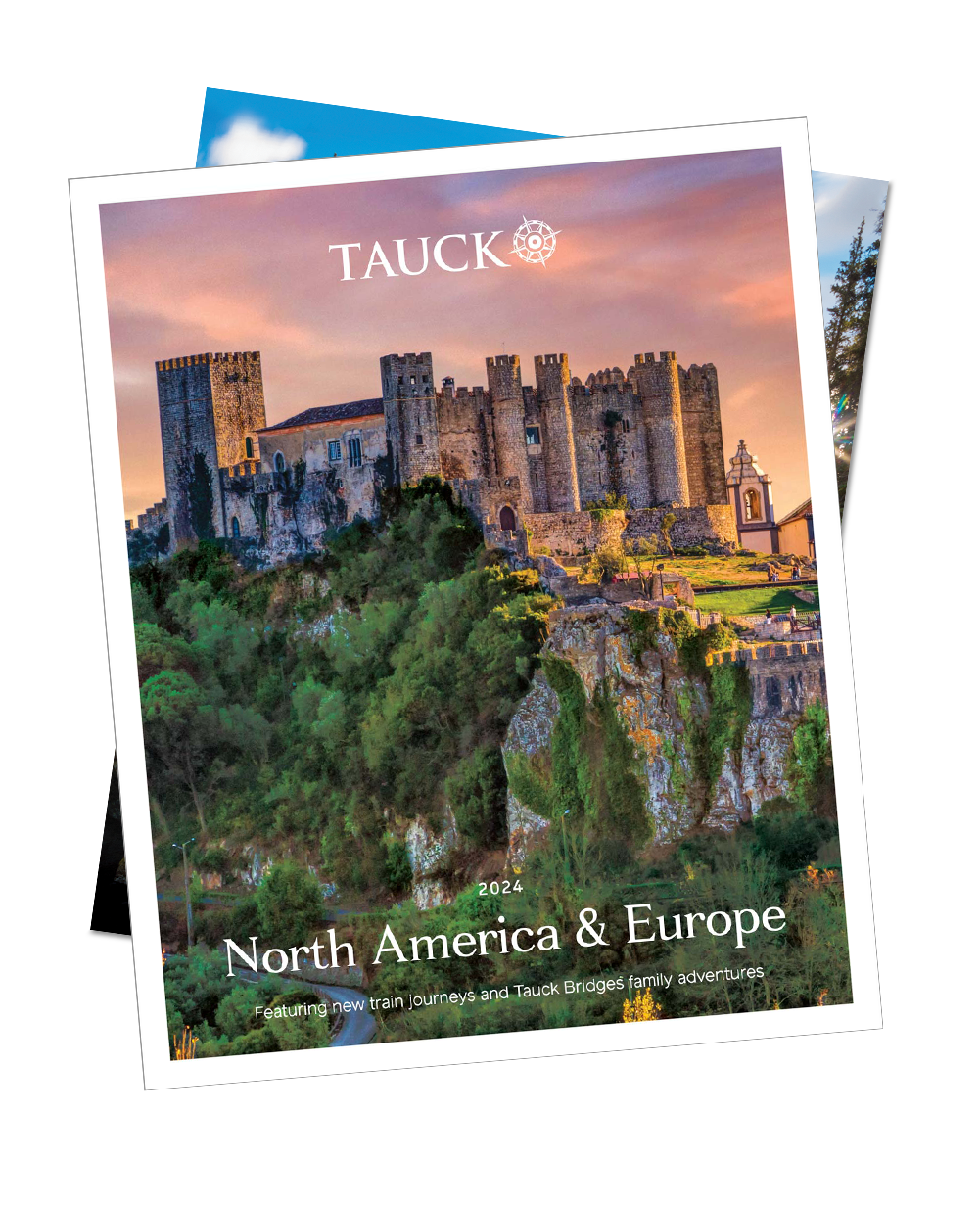
Related Journeys
Other Journeys You May Enjoy
Yellowstone & grand teton national parks.
From $4,990
Land Journey
- Destinations
- Antarctica & the Arctic
- Australia & New Zealand
- Israel & Jordan
- Latin America
- United States
- Tours & Cruises
- Exclusive Partnership
- Family Journeys
- Guest Favorites
- River Cruises
- Small Groups
- Small Ship Cruises
- Awards and Accolades
- Our History
- Tauck Impact
- The Tauck Difference
- The Taucker Blog
- About Tauck
- Media Center
- Tutorial Video
- Agent Connect
- Register Your Agency
- General Information
- Travel Protection
- Newsletter Sign Up
- Order an eGift Card
- Request a Brochure
- Tauck Forums
- Travel and Health
- Travel Updates
Sign Up to Subscribe to Our Emails

IMAGES
COMMENTS
CIRCLE JOURNEYS & RETURN JOURNEYS. Save up to $1,000 per couple on invigorating round-trip journeys through the Canadian Rockies or American Southwest. Experience a Circle Journey that connects two of our iconic rail routes for more days to explore Canada's natural wonders, or take a Return Journey for more time to explore Denver and Moab.
Select the trip length that you are interested in. To learn more about the inclusions of each trip length, click on the tooltip. Any Length; 1-3 Nights; 4-6 Nights; ... Rocky Mountaineer Train; Nights. 1. Compare ; Learn More. Featured Package From. $19,790.40. Rainforest to Gold Rush Grand Adventure 2024 Season.
Our rail routes travel to some of the most iconic and memorable places in North America, allowing you to explore incredible destinations. Whether you chose to book one of our packages that already includes activities and tours, or chose to customize your journey with our curated list of optional add-ons, we want to make sure you have an unforgettable journey.
Adding tours, side trips and excursions before or after your Rocky Mountaineer journey adds a whole new layer of experience to your adventure. From gondola rides up Sulphur Mountain in Banff to heli-hiking in the Cariboo Mountain Range, there are more than 65 Rocky Mountaineer packages and activities to choose from.
COLBY KIRKPATRICK/THE POINTS GUY. Rocky Mountaineer, a Canadian company that's been taking travelers on high-end rail tours of western Canada for more than 30 years, launched its first U.S. route in 2021. Called Rockies to the Red Rocks, this itinerary connects Moab, Utah, with Denver, Colorado, and offers travelers a new way to experience the ...
The Rocky Mountaineer connects British Columbia and Alberta, with stops in Jasper, Lake Louise, Banff, Vancouver, Whistler, Quesnel and Kamloops. The train runs from mid-April until mid-October. The Rocky Mountaineer is a daylight-only train designed so that passengers can experience the most spectacular views and optimal photo opportunities.
Rocky Mountaineer debuted its first U.S. route in the fall of 2021, taking passengers between Denver, Colorado and Moab, Utah with an overnight stop in Glenwood Springs, Colorado.
The Rockies to the Red Rocks route is a new two-day trip between Denver and Moab or the reverse, Moab to Denver. It's also Rocky Mountaineer's first route in the United States. The train crosses the Continental Divide, winds past verdant mountains and carves through a series of dramatic canyons into red rock country.
After all, the jaw-dropping vistas are the main highlight of the Rocky Mountaineer's newest route between Denver, Colorado, and Moab, Utah. Aptly named Rockies to the Red Rocks, this route is the ...
When it comes to planning Rocky Mountaineer train travel, there are 4 things you should know right off the bat: ... On the stuffy side, "Mr. Blount" has been a writer, consultant, and published author with the likes of Simon & Schuster and McGraw-Hill. Recently retired from a 35-year career as a middle school teacher, Howard enjoys spending ...
A Rocky Mountaineer rail journey is a luxury train experience that takes place in British Columbia and Alberta Canada. Book with Prince Adventures Travel to ensure you get the best advice and guidance, fro ... from a travel advisor who has actually taken a Rocky Mountaineer First Passage West train trip. ... sit on the left side of the train ...
Rocky Mountaineer. Dramatic views of lofty mountain peaks, deep forests, and pristine waterways frame the way for some of North America's most impressive rail routes on Rocky Mountaineer. The train sets a new standard for railway excellence, and as a result, has been hailed as the gold standard for train travel since its inaugural route in 1990.
Preparing to Go. Now that you've booked your rail journey, you're one step closer to untouched landscapes, exceptional service, and miles and miles of memories. To help you prepare for the adventure ahead, we've created this guide that includes everything you need to know prior to travel, as well as helpful tips and information. Adventure ...
With two of Western Canada's best outdoor adventure hubs on this train journey, Whistler and Jasper, this rail route is the perfect fit if you love exploring nature. Choose this route if: Spending a free afternoon in Whistler excites you, and you're thrilled to spend 2.5 days on the train (remember, you don't spend the night on the train!).
Rocky Mountaineer Review - Unsurpassable Luxury Travel. We joined the First Passage to the West, which traverses the classic route from Vancouver to Banff through the Continental Divide and into the spectacular ranges of the Canadian Rockies.. This particular journey is the most popular trip that Rocky Mountaineer offers, and it's the one that most people have visions of when planning ...
On the plus side, the main Rainforest to Goldrush train now runs direct to and from North Vancouver station and you still get half a day at leisure to explore Whistler, a ski resort and sort of Canadian Zermatt. ... Tailor Made Rail can also organise a Rocky Mountaineer trip. Call their dedicated seat61 phone line 020 3778 1461 and quote seat ...
CIRCLE JOURNEYS & RETURN JOURNEYS. Save up to $1,000 per couple on invigorating round-trip journeys through the Canadian Rockies or American Southwest. Experience a Circle Journey that connects two of our iconic rail routes for more days to explore Canada's natural wonders, or take a Return Journey for more time to explore Denver and Moab.
The World Travel Awards named the Rocky Mountaineer the winner of the 2021 world's leading luxury train, ... only this time with a side of hummus, carrots, and broccoli. On day two, the breakfast ...
The Rocky Mountaineer stationed in Glenwood Springs, Colorado. Monica Humphries/Insider. I took the Rocky Mountaineer train from Denver, Colorado, to Moab, Utah. The once-in-a-lifetime trip ...
The moderately active Salt Lake City to Denver by Rocky Mountaineer adventure takes place in the mountain heights of Utah and Colorado and the Mile High City of Denver Colorado at 5,276 feet (1,608 meters). To enjoy this trip, you should be in good health and able to walk reasonable distances, often over unpaved and uneven surfaces.